Already a student? Click here to login
Create Your Deepest Art In The …

Imagine creating amazing art , step-by-step, in this 5 Module online course delivered weekly over 5 weeks where you’ll learn to believe and trust in yourself, so you can create art with confidence, deeply explore and experiment, and embrace the unknown.
This is for artists of all levels , whether you’re at the beginning of your artist’s journey, coming back to your art after years of not painting or you’re a seasoned professional.
Questions? Click Here To Book a Clarity Call
WHAT YOU GET WHEN YOU JOIN TODAY:
Create amazing art in this 5 Module abstract painting course that is delivered weekly over 5 weeks. In The Artist’s Journey course, you’ll learn to believe and trust in yourself, so you can create art with confidence, deeply explore and experiment, and embrace the unknown. This is how you create astonishing art.
Join our fabulous private Facebook Community where the excitement happens: the exchange of ideas, inspiration, encouragement and friendships flourish in this wondrous, dynamic community of artists.


WHAT THE ARTIST’S JOURNEY CAN DO FOR YOU AND YOUR ART
Click on the arrows or swipe left to read more testimonials
Teresa has experienced a turning point in her art

~ Teresa Pisani
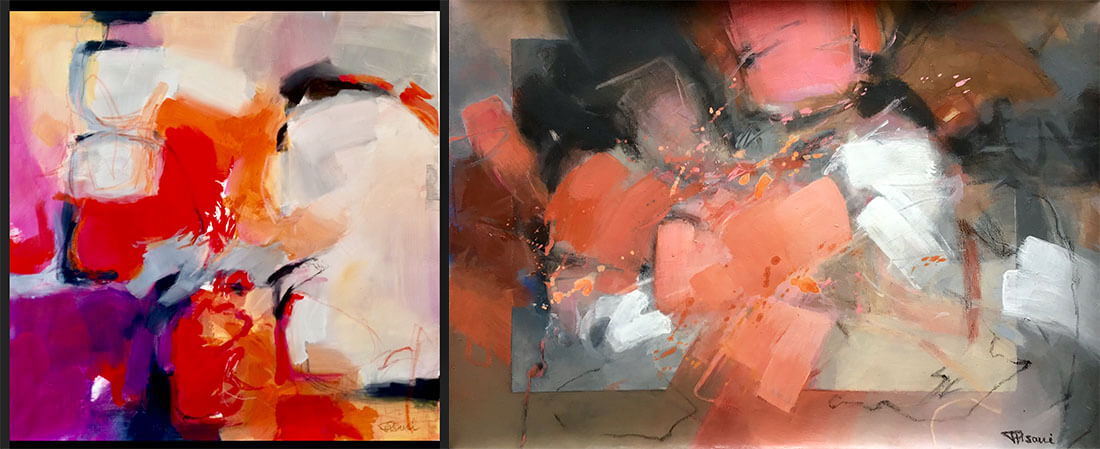
Chrissy now understands the path to her best work

~ Christine Scurr
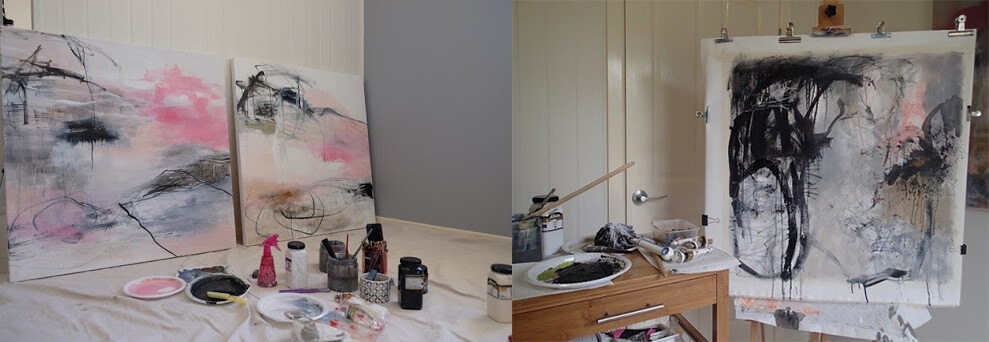
Vera took her painting to a new level

~ Vera V. Tchikovani, San Francisco, CA, Artist’s Journey® Course Alumna

Betty found her own style
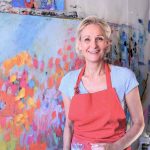
~ Betty Franks Krause
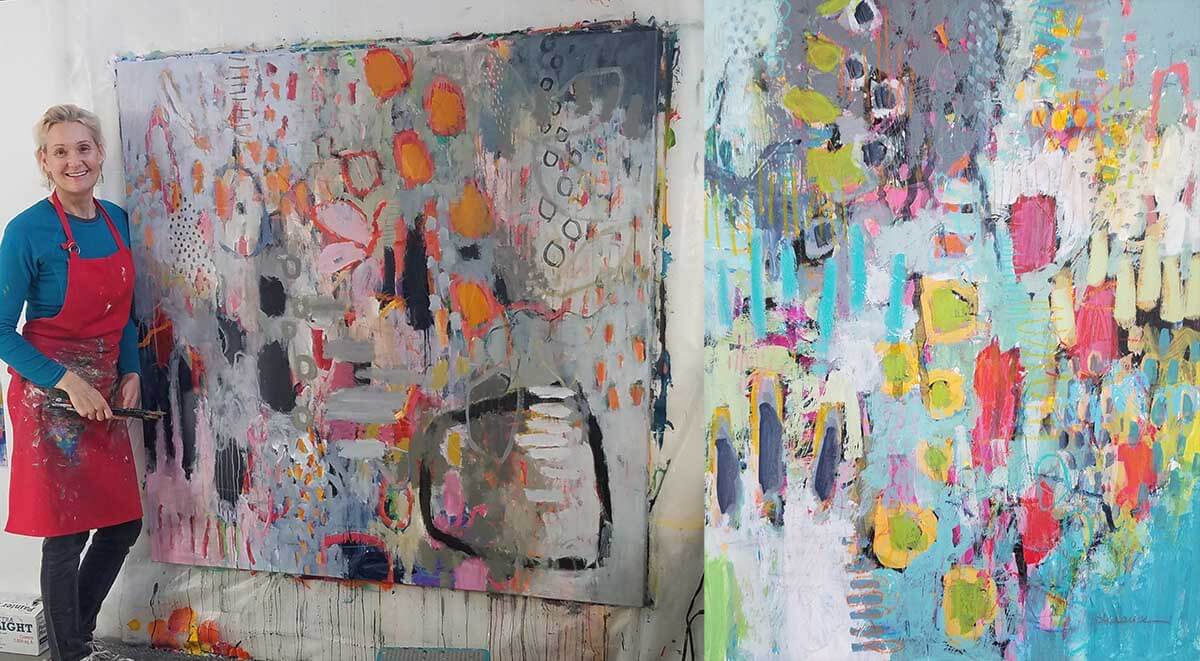
Marian incorporated painting with her yoga practice
The Artist’s Journey Course Work and Nancy’s abiding trust and encouragement are the cornerstone of my artistic development. Watching her simultaneously paint and teach is captivating and spellbinding. I’ve travelled from nascent “yeah kind of” artist to one who races to her studio, eager to spend time painting, experimenting, exploring, allowing, and finally, liking my work. Grateful to Nancy forever! Namaste!
~ Marian Bach

“In the middle of the road of my life I awoke in a dark wood Where the true way Was wholly lost.”
Do you ever feel that way?
Dante Alighieri wrote those words over 600 years ago, yet they could have been written today by painters like you and me.
I remember as a child, I would sit in front of two Rembrandt reproductions that hung in the living room of my childhood home in Arkansas. For hours, I’d get lost looking at them: Young Woman with a Broom and The Man with the Golden Helmet .
As I looked into the sitters’ eyes, I imagined their personalities. What would they say if they stepped out of the paintings and sat down on the floor next to me? What were they like? I imagined playing with them and listening to them tell me stories about their lives.
I dreamt of being an artist for as long as I can remember.
But the swirl of life’s currents swept me away from that dream. I explored drama, debate, writing, biology, and chemistry. I became a psychiatrist. But then one day, that long-ago fascination with art resurfaced out of the depths.
At 36, I was brought to tears when I finally saw original Rembrandt drawings while on a painting trip in southern France. They were so alive, the people in those renderings reaching out to me across the gulf of the past.
That aliveness is what I’ve always loved about painting — yet it can get lost along the way.
So many painters are filled with self-doubt. They question their talent. Creation becomes an arduous, painful task. They retreat into technique, hoping to find that one last, secret method that will finally make them “great.”
They get their work critiqued…until they can no longer paint without a voice in their heads picking apart everything they do.
They compare themselves to other painters, and always seem to find themselves coming up short.
Along the way, their work becomes “dry.” Dead. Like a butterfly pinned to a board. Beautiful — but lifeless.
Do you ever feel that way about your work?
It’s a terrible place to be. To love something — painting — but to find it so painful. To feel lost, wanting to express yourself but not knowing how. To feel like nothing you create is really you.
You yearn for something more. To create. To feel alive.

What’s missing in all of these problems is YOU. Your soul and aliveness coming through in your art.
I would know, because I used to be the same way.
For years, I painted figures and landscapes that were beautiful, technically excellent, and got into solo shows and galleries…but they were predictable. I became bored and uninspired. I never surprised myself.
I wanted wonder and joy. I wanted magic! I wanted to fall in love with painting again.

Imagine Being Excited to Paint Again!
Imagine waking up every day and feeling excited to show up to the studio and explore and experiment .
Every time you pick up the brush, you hear an internal voice that says: “I can do this, I will do this” . Hours go by as the work pours out of you. You feel like a child again — before the doubting voices and criticism got to you.
You create paintings that surprise and delight you. You’re free of self-judgement and the constant questioning of “am I good enough?” Y ou say “yes” to taking the plunge into facing your fears and creating fully.
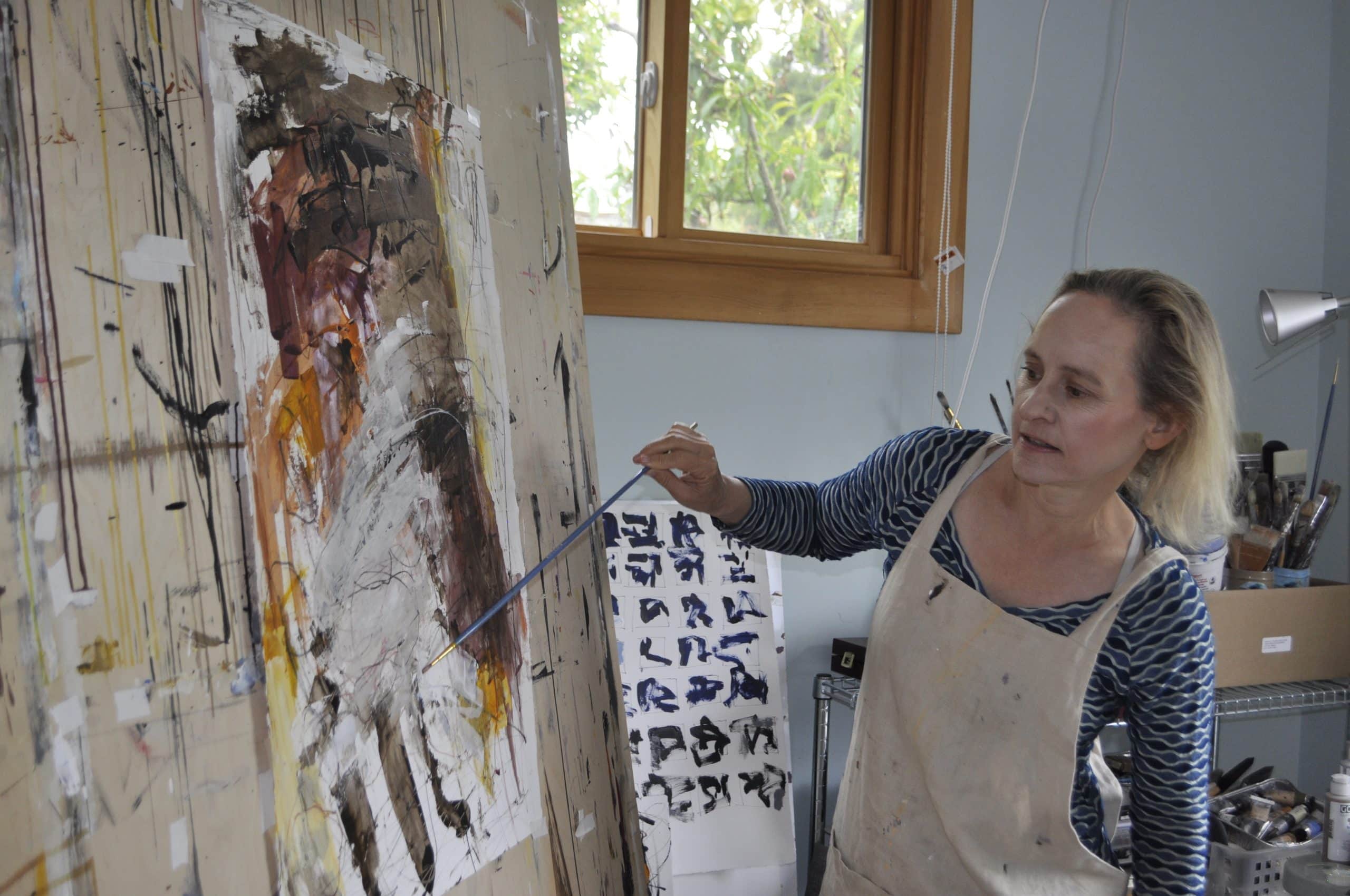
Hey there, I'm Nancy
I'm an abstract artist, bestselling & award winning author of The Artist's Journey® and The Adjacent Possible® books as well as a Stanford educated psychiatrist.
I’ve been an artist and existential psychiatrist for over 20 years and I'm passionate about creativity, aliveness, and living your most meaningful life.
I've been an abstract painter for decades. Several years ago I created a television program " Creativity & Consciousness " where I interviewed artists on their creative process. I learned that artists in every genre grapple with fear and self-doubt and that the interior landscape affects everything!
I believe that abstract painting is a powerful way of getting at meaning and that art is a mirror that reflects our lives … the canvas reflects back our feelings, moods, interior states, and life.
I've guided thousands of artists in creating their deepest, most alive and meaningful work, and I would love to be your guide, too!

What You’ll Learn
The one inner transformation that makes all the difference on your artist’s journey . Master this, and your procrastination and fear around painting will disappear.
The secret “Holy Grail” of prolific, successful artists who appear in galleries (it’s a triple threat).
Many ways of starting your abstract paintings , so you never spend hours staring at a blank canvas in frustration again.
One simple compositional constraint that works every time. Use this when you’re stuck, and you’ll quickly set the “frame” that frees you to express yourself within it.
A simple way to make your painting feel monumental so you can explore the power of scale in your art.
The value of simplifying values in a painting (believe it or not, this can be more important than color and is something all the masters are experts at).
How to use contrast in your paintings, so you create visual excitement, interest, and drama.
How to quickly fix common compositional problems, so each painting just “works” as a unified whole.
Considerations on finishing your paintings, so you don’t get stuck in “what now?” mode and can quickly decide when a painting is done.
And much, much more!
This course has inspired and provided me with all the concepts that forms the foundation of abstract painting. Moreover, t hrough the Facebook group of this course I have received multiple feedbacks from other talented artists who have contributed towards my authentic painting in this course.
~ Ashwini Prasad

How The Artist’s Journey® Works
The Artist’s Journey® explores abstract painting in 5 modules which you’ll receive over the course of 5 weeks.
Each week you’ll receive an email guiding you to the new module. You’ll receive a Focus Message at the beginning describing what you’ll explore, what you’ll do, and what you’ll complete in that module.
Each module includes a Reflection Exercise , a Slideshow Masterclass , and How-To Videos demonstrating the concepts explored, and 2-7 painting exercises in the first 4 Modules. Module 5 is a wrap-up.

Focus Messages

Reflection Exercises

Slideshow Masterclass

How-to Videos
Painting exercises.
YOU CAN ACCESS THE MODULES ON YOUR COMPUTER OR PHONE
Follow the simple, step-by-step instructions in each module, and you’ll be able to create abstract paintings that you LOVE in no time at all.

I kept going back to different parts of the course to push it further and remind myself to keep coming back to being free to experiment. It’s extremely relevant to experienced artists as well as people wanting to start creating art. Having painted for quite a few years I was concerned that it might not suit me…. so wrong… I have such a new energy to my work and a very different process, especially when painting plein air . I get a real sense and energy to the landscape which I can bring home to the studio to work up into bigger paintings.
~ Ann Armstrong
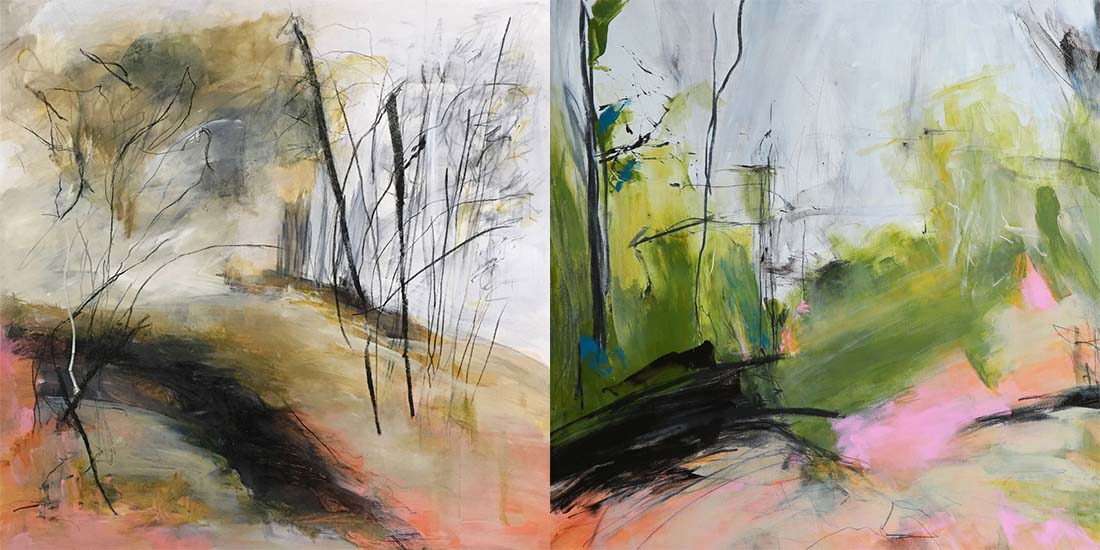
What You’ll Learn In The Modules

Nancy is vivacious & interesting in her presentation of the modules in the courses, which I have enjoyed immensely.
Having completed The Artist Journey course & Studio Journey, I have been provided with invaluable information, developed a very strong studio practice & the love of exploring & experimenting.
My work has indeed gone to a new level, for which I thank Nancy & am eternally grateful.
Throughout my 4 year association with Nancy, I have made many new friends through the special Facebook groups & have enjoyed chatting with these “like minded” artists & viewing their work. I have also been fortunate to meet some in Australia in person, we have formed a lovely friendship .
Thank you, Nancy for these wonderful opportunities.

~ Cornelia Lehmann

Each lesson is supported by a video in which Nancy paints a picture from start to finish. That was very helpful for me.
It is such a great gift that I was able to experience thanks to these courses. I have finally found my way to paint as it suits me.
When I paint, I feel that I paint from my innermost source. And when the picture is done, it’s exactly what I want to show. I can finally identify with my pictures. I would like to thank Nancy for that.

~ Cheryl Dyment
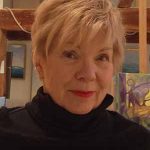
I am so glad that I decided to jump into your class mid-way, after speaking with you. While the progression wasn’t the orderly manner in which I would normally approach things, it was there, nonetheless. I have just finished going through the modules and now I am looking forward to going back and completing the many exercises that I couldn’t manage on my schedule. I have never taken an online course before, and this has really worked out well for me.
Your lessons are well structured and the demos, very helpful. Most of all, your positive encouragement and attitude helped me realize that I am in the right place, with the right “guide” to move me along my journey. I have also enjoyed making the leap to use acrylics and paper, both firsts for me. I have been painting with oils forever, and the change up in mediums has been fascinating.
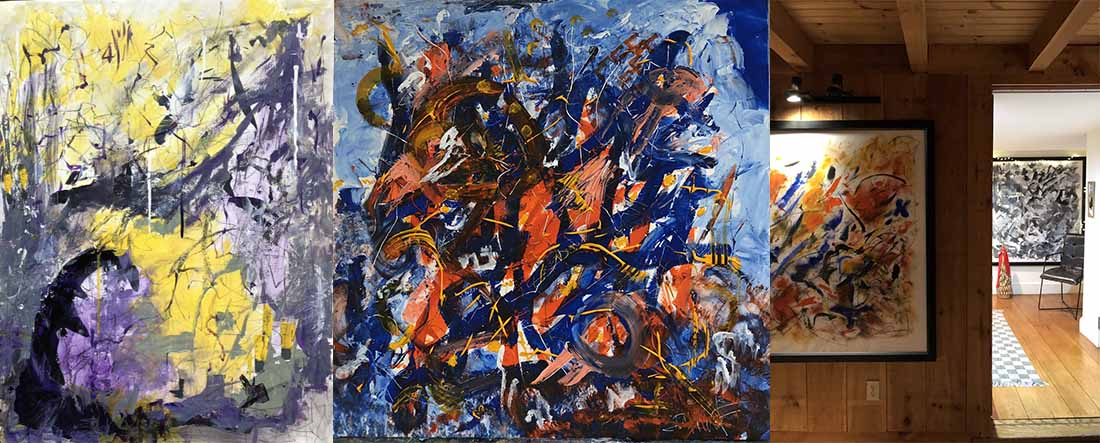
~ Maja Jiranek
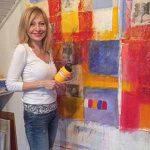
~ Marilyn Simler

Nancy has freed me from a more observation based working method to intuitive free mark making. A combination of the two is beginning to surface which is probably my true self!
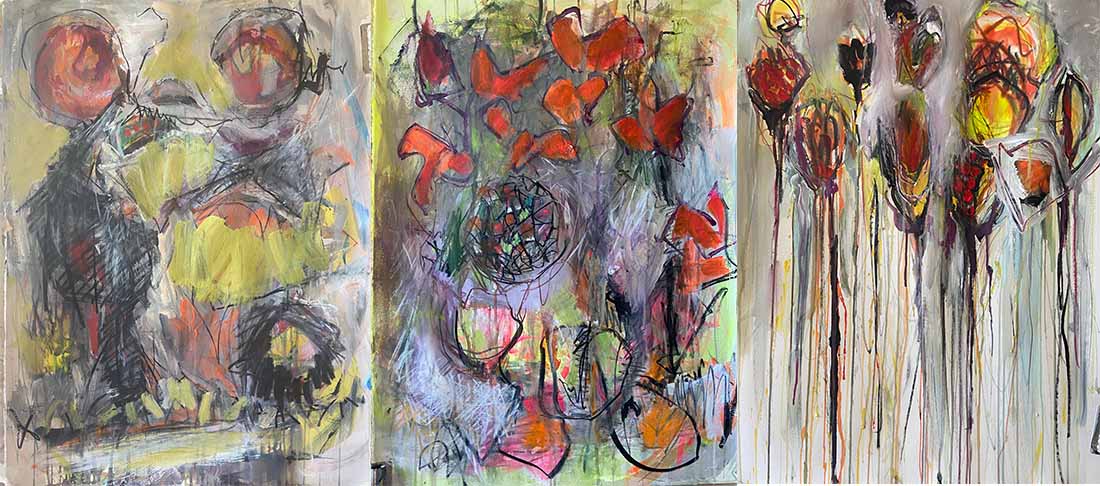
~ Amanda Sophia Hocking

I have not done a lot in the area of abstraction but I wanted to do something that took me away from my “controlling” self and the exercises and weekly challenges have done just that. I have deliberately chosen to spread the course out over 3 months so that I can savour every moment yet still be able to further my other art/horse training commitments.
I have found a lot of parallels in the Course and training horses which comes as no surprise as you are a horsewoman, too. Such as; to ride in harmony with a competition horse you have to be prepared to be straight with yourself. It takes courage to step out of your comfort zone but the gains are always worth it. Be prepared to make mistakes, learn and move on. Surrender yourself to the process and not get caught up in the “in order to’s”.
Each horse/painting is on a different journey to the one you rode before. Make lots of starts it improves the chances of success. Every test/painting is a WIP not the “Be All and End All” of Success. And most of all to lighten up and have fun with it.

~ Nina Thorne

I loved the clear and detailed structure of the course, the excellent instructional videos, and the reviews of important aspects of painting, including mark making, elements of composition, color, restraint, risk taking, trust etc. For me, it was especially helpful to be encouraged to trust my own creative expression and to distance from the inner critic. This process of opening and accepting was beautifully facilitated by concepts like „many starts“ and the Marquettes.
I have used everything I learned in this course over the past year and I find that my work is evolving in new and exciting ways.
I will be forever grateful to Nancy for offering this course and would recommend it to anyone. By the way, I also took the Color course and found it equally satisfying , informative, and rewarding.

Creativity is central to feeling alive.
Will you finally say YES to your dreams?
Artists suggestions based on your preferences
Filter by media, style, movement, nationality and activity period
Search artists by name or category
Notable sales happening this month
Browse all types of artworks for sale
Overall performance of recent notable sales
Detailed results for millions of lots
Upcoming exhibitions at your preferred locations
Global snapshot, top performers and top lots
Charts on artist trends and performance over time, ready to export
Get your artworks appraised online in 72 hours or less by experienced IFAA accredited professionals
Get the best price for your artwork or collection.
We notify you each time your favorite artists feature in an exhibition, auction or the press
Access detailed sales records for over 738,000 artists, and more than two decades of past auction results
Buy unsold paintings, prints and more for the best price
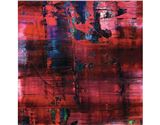
On Artists’ Journeys and Their Meanings
Many artists undertook arduous travels to reach new environments in search for inspiration. These often resulted in lifechanging experiences for artists, and treasures for art history
Bianca Spaggiari / MutualArt
Aug 29, 2023
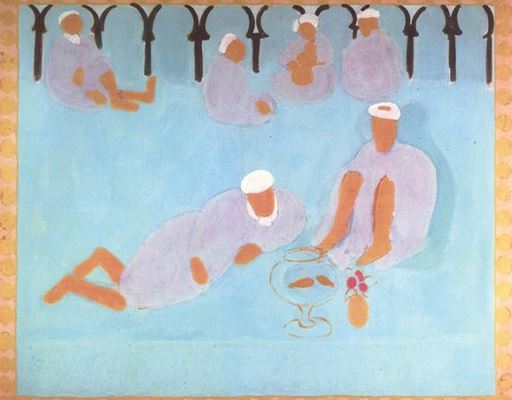
As the summer comes to an end, most of us look back on our recent journeys – be it far or close. Off a plane, onto a train, and then a boat. All steps that are quick and casual to modern man. This ease of displacement wasn’t always the case, however. Nonetheless, in their search of inspiration, artists of the past centuries overcame tough travelling conditions in order to undertake life-changing voyages. Common threads exist in the way artists used to travel and the motivations behind those undertakings, most notably that no matter the length of the trip, the real journey was always the inner one.

Vincent Van Gogh , The Langlois Bridge at Arles with Lady and Umbrella, oil on canvas, 49.5 x 64 cm, 1888, © Courtesy of Wallraf-Richartz Museum, Cologne
Vincent Van Gogh , incapable of fulfilling his family’s plan to become a clergyman, at thirty-one left the emerging Dutch art scene and moved to France, aiming to dig deep into the depths of his personality. There, Van Gogh started painting landscapes, a booming genre at the time. This was a common initial feature to many artists as they shifted to a new environment. As time went by and they became more acquainted with the area, they often decided to focus on details, those that visually define the place. In the case of Van Gogh, he arrived in Arles amidst snowfall in 1888. Several weeks later spring sprung, instigating a highly prolific period for the artist. He produced nearly fourteen canvases set in the blossoming fields of the town, first focusing on the Langlois Bridge on the Arles Canals, and then on specific types of trees. The colors he applied in the Provence stand at odds with those in the rest of his paintings. The tones are softer, almost carefree and cheerful, reflecting an inner joy of the artist in beholding fresh environments. Travel allowed Van Gogh to express his (initially) relieved senses through art.

Henri Matisse , Moroccan Café, size colours on canvas, 176 x 210 cm, 1913, © Courtesy of Hermitage Museum, Saint Petersburg
Likely pushed by the same desire, Henri Matisse ventured further south to Morocco in search of the exoticism long lost in Paris. Matisse travelled to Morocco two years in a row, in 1912 and 1913, resulting in a pivotal phase of his career. Despite the initial disappointment of days of uninterrupted rain and a slight cultural clash he reported in a letter to a friend, his artistic practice benefitted extremely from the Mediterranean air and new motifs. Matisse was enthralled by the wild vegetation, and with the little he could do during the rainy days, he started focusing on the view from his window. Once he could, he began portraying tiled roofs, the blue- and green-imbued environment, and local scenes, like in Arab or Moroccan Café . The canvas depicts a moment of daily reverie, the people of Tangier gathering to leisurely sip a cup of coffee. The canvas presents blurred and soft nuances as well as a flattened surface, in contrast to other paintings from his Moroccan period, which feature strong color juxtapositions.

Paul Gauguin , The Seed of the Areoi, Oil on burlap, 72 x 92 cm, 1892, © Courtesy of Museum of Modern Art, New York
Unlike Van Gogh and Matisse, Paul Gauguin ’s move to Tahiti led to a feeling of disruption and disappointment due to the increasing Western colonization. He sought ways to plunge himself into the remotest parts of the island, the paradise lost he had been looking for. On many levels, travelling meant to Gauguin searching for a mindful quest and creative liberation, as well as denying and dismissing his origins to study and absorb Tahitian culture. In this period, he produced many portraits with gorgeous feminine figures. Te aa no areois was the original title of The Seed of the Areoi , as the majority of his works were titled in the local language. The painting portrays the order of the Areoi anachronistically, but it was meaningful to Gauguin to depict the historical narrative of the place by linking past and present. During his travels in the South Seas, he developed a more descriptive, personal and expressionistic style, slowly detaching himself from Post-Impressionism. Even if the art world may be divided over Gauguin’s personal legacy, these works served as a reference for many subsequent artists.

Edward Hopper , Gas, Oil on canvas, 66.7 x 102.2 cm, 1940, © Courtesy of Museum of Modern Art, New York
Edward Hopper , on the other hand, didn’t travel to find company. He sought to dissociate from the hustle and bustle of American society, as he also artistically denounced its fleeting moments where people felt lonely and alienated. He enjoyed driving in his car around limitless America as a solitary man. Taken by the twenty-four-hour diners, the gas stations and the neon motel signs, Hopper mentally captured those scenes and later transferred them onto canvas, ending up having too many works depicting the same themes. He found poetry in desolate spaces, inspiring the same in the viewer, without insisting. Using oil colors, he accentuated the artificial light over the natural light at dusk. The gas attendant is synonym for solitude, further dramatized by bright tones.

Georgia O’Keeffe, Red Hills with Flowers, Oil on canvas, 50.8 × 63.5 cm, 1937, © Courtesy of 2018 Georgia O'Keeffe Museum/ Artists Rights Society (ARS), New York
Georgia O’Keeffe found her resilient soul alive in New Mexico. Santa Fe at the time was a popular destination for artists. O’Keeffe was given a studio there to paint and a place to stay and she fell in love with the ubiquitous presence of nature. She spent most of her days outdoor, depicting landscape variations in her paintings, from stark desert scenes to flowery patterns and blue skies, exploring the abundance and void of colors through swaths of tints. She termed New Mexico the wilderness and wonder of the world and after visiting a first time, she came back to stay. In Red Hills with Flowers, she juxtaposes enlarged flowers with mountainous landscape made of sensuous red peaks. She asserted that “All the earth colors of the painter’s palette are out there in the many miles of Badlands. The light Naples yellow through the ochres — orange and red and purple earth — even the soft earth greens.”
To travel is to free the mind and make room for the unexpected to enrich one’s life. That is what drove artists to near and far lands, where they experienced different environments and lifestyles, resulting in highly prolific periods for them, and countless artworks for us to treasure as part of art history. Many of these works went on to serve as references to what certain places looked like, but, even more so, we can sense what impression they made on the artist. Therein lies the beauty and intimacy of painting, which, rather than just transmitting a point of view, serves as a gateway to the artist’s feelings too.
For more on auctions, exhibitions, and current trends, visit our Magazine Page
Related Artists
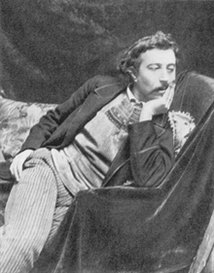
Paul Gauguin
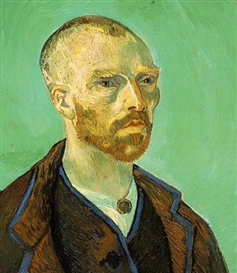
Vincent van Gogh
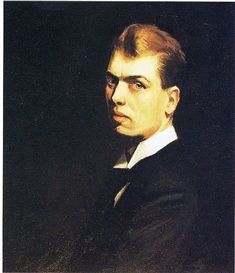
Edward Hopper
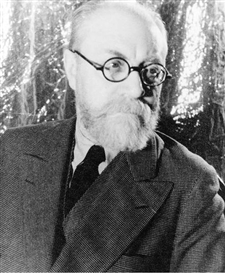
Henri Matisse
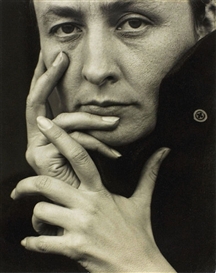
Georgia O'Keeffe

Student Resource
Journeys Coursework Guide
From physical journeys and migration to journeys of self-discovery, get ideas and inspiration about journeys in art
Journeys in art
Explore art terms related to journeys, more for students and teachers.
Ford Madox Brown The Last of England (1864–6) Tate
Mark Wallinger Threshold to the Kingdom (2000) Tate
© Mark Wallinger
Lubaina Himid CBE RA Between the Two my Heart is Balanced (1991) Tate
© Lubaina Himid, courtesy the artist and Hollybush Gardens, London
Kara Walker Grub for Sharks: A Concession to the Negro Populace (2004) Tate
© Kara Walker
Ellen Gallagher Bird in Hand (2006) Tate
© Ellen Gallagher
Simon Starling Five-Man Pedersen (Prototype No.1) (2003) Tate
© Simon Starling
Carl Plackman The Immigrant (1985–7) Tate
© The estate of Carl Plackman
Whether documenting a journey from A to B; exploring and responding to places; or using historical or personal journeys in order to better understand identity, artists have used different kinds of journeys to inspire their art over centuries.
Journey can refer to an actual physical journey – travelling from one place to another; wandering around a particular urban or landscape location in order to explore it; or enforced migration such as the journeys made by slaves or refugees. However journeys don’t always have to involve physical travel. The term ‘journey’ is often used to describe the journeys we make in life: such as personal experiences that involve an element of self-discovery or more generally the journey through life – growing up or getting old. Journey might also be used in relation to formal processes in art making, for example in the work of artists whose process dictates the end result of the work.
Land art and urban mapping
Hamish Fulton Wind through the Pines (1985, 1991) Tate
© Hamish Fulton
Land artists such as Hamish Fulton and Richard Long use walking as a way of exploring landscapes. Hamish Fulton records his experience of the walks he makes in poetic texts. In Wind through the Pines 1981 the things he sees, hears and experiences are transformed into descriptive sentences or single words which together evoke the sense of journeying through a landscape. Richard Long’s A Line Made by Walking creates a temporary sculptural intervention in the landscape as the route he takes across a field flattens the grass and becomes a trace of his journey.
Edward Ruscha Filthy McNasty’s (Sunset Strip Portfolio) (1976, printed 1995) ARTIST ROOMS Tate and National Galleries of Scotland. Lent by Artist Rooms Foundation 2011
© Edward Ruscha
Ed Ruscha journeys through the urban spaces of Los Angeles in order to create a portrait of the city, often collecting these photographs together to form photobooks . For his Sunset Strip Portfolio he photographed every single building on the Hollywood Strip in LA, a mile-and-a-half strip of Sunset Boulevard in West Hollywood. In doing so he not only gave a sense of moving from a point at one end of the strip to the other, but also captures the history of the city, and provides a snapshot of its socio-economy as reflected in the changing nature of the buildings and businesses.
Psychogeography: The politics and poetics of locations
The term psychogeography refers to an approach to geography that emphasizes drifting around urban environments in order to explore the effect of particular locations on emotions and behaviour. Ruth Ewan’s The Darks is an alternative audio guide to Tate Briatin which invites visitors to navigate the area around the building where the notorious Millbank Prison once stood.
This film file is broken and is being removed. Sorry for any inconvenience this causes.
Patrick Keiller’s films record the exploratory journeys around England of a fictional, unseen character called Robinson. Robinson’s chance encounters with various locations cause him to reflect on the significance of places and what he sees there in relation to greater global themes – such as the economy or politics. For his installation The Robinson Institute at Tate Britain in 2012 Keiller selected images of landmarks and locations in the English landscape from Tate’s collection, to illustrate the development of capitalism.
Susan Philipsz uses her own voice to create uniquely evocative sound installations that play upon and extend the poetics of specific, often out-of-the-way spaces. For Lowlands , she uses an old Scottish folk song to explore the spaces around and under three bridges along the River Clyde in Glasgow.
Willie Doherty’s photographic work The Bridge is made up of two views from either end of Craigavon Bridge which crosses the River Foyle in Belfast, marking a point of connection between the Protestant and Catholic communities in the city. The photographs demonstrate that the perspective may be different but the view is almost identical. The bridge divides the two communities but also links them and has the capacity to be a point of meeting and exchange.
Willie Doherty The Bridge (1992) Tate
© Willie Doherty
Artist Francis Alÿs journeys along borders and boundaries in order to raise awareness of political issues. For The Green Line 2004 Alÿs walked around Jerusalem, trailing a ribbon of green paint behind him. He was following the so-called green line, which was drawn on a map by the Israeli Minister of Defence Moshe Dayan at the end of the Arab-Israeli war of 1948–9 and has become one of the most contestded boundaries in the world. It marked the respective positions of Israeli and Arab forces in the final ceasefire, and it has served as a boundary between Israel and the West Bank ever since.
Migration – whether enforced through slavery, through escaping war or disaster, or triggered by economic needs – has played an important role in the lives and histories of many people and is a theme that has been widely explored in art. Ellen Gallagher’s Irish and African American origins have shaped the texture and subject matter of her practice. Bird in Hand refers to the experience of slaves of the Cape Verde islands off the West Coast of Africa, the birthplace of the artist’s father, a region that was for three centuries a hub of the transatlantic slave trade. Kara Walker’s room-sized installations of silhouette cut-outs explore the narratives and journeys of Black history, its telling and re-telling, and the effect this has on African-Americans today.
Lubaina Himid was born in Zanzibar in Tanzania but moved to England with her parents shortly afterwards. One of the founding members of the Blk Art Group – formed by British artists whose parents were Caribbean and African migrants – her paintings, woodcuts, installations, works on paper and curatorial projects emphasise the contribution of African migrants to the development of European culture. Between the Two My Heart is Balanced 1991 is a large painting depicting two black women dressed in African-style clothing at sea in a small grey boat. The title of the work suggests the struggles for identity and belonging faced by migrants.
Cuban performance and installation artist Tania Bruguera’s ongoing art project, Immigrant Movement International is an artist-initiated socio-political movement which aims to explore who is defined as an immigrant and the values they share, focusing on the question of what it means to be a citizen of the world. For her 2012 work Surplus Value at Tate Modern, visitors to the gallery were given a taste of some of the experiences immigrants have to face.
Personal journeys: Identity and life journeys
Bill Viola Nantes Triptych (1992) Tate
© Bill Viola Studio
Although all the journeys referenced so far in this resource have included personal experience as well as referencing a geographical journey, there are some journeys that do not involve geographic travel but soley relate to life, personal experience and exploring identity. Bill Viola’s Nantes Triptych is a three panel video installation with video footage of birth (on the left), death (on the right) and a metaphorical journey between the two represented by a body floating in water (in the centre). Viola uses his personal experience of birth and death (the birth of his son and his Mother’s death) to exlore the universal experience of the journey of life, but in doing so also expresses his own personal response to these two momentous events.
Tracey Emin’s Exploration of the Soul 1994 also explores the journey of life. It is comprised of thirty-two framed sheets of blue A4 notepaper on which Emin has written a poetic text recounting significant moments in her life from birth up until the age of thirteen.
Donald Rodney In the House of My Father (1996–7) Tate
© The estate of Donald Rodney
Facing up to and coping with big things that effect our life such as the break up of a relationship or suffering from an illness can become a journey of self-discovery. Artist Jo Spence was diagnosed with cancer in 1982 and much of her subsequent work was a response to her treatment by the medical establishment and her attempt to navigate its authority through alternative therapies. As well as addressing ideas of identity, family, home and Britishness – particularly with respect to a British, Afro-Caribbean diaspora – Donald Rodney’s work explores themes of mortality and his own illness. Rodney suffered from sickle cell anaemia, an inherited disease that affects people of African, Caribbean, Eastern Mediterranean, Middle Eastern and Asian ancestry. In the House of My Father is a photograph of the artist’s hand holding a small fragile house constructed from pieces of his own skin removed during one of the many operations he underwent to combat his disease. The artwork symbolizes his illness but also the journey the illness has taken him through, in relation to his identity and his relationship with his father.
Process: Journeys in art making
Journeys in art can also be those that relate to the formal processes of art making. Artist Paul Klee famously described the process of drawing as ‘taking a line for a walk’. Some artists create work using systems that dictate the journeys they will make in their creative process. For his Chance and Order Group VII, Drawing 6 1971 Kenneth Martin used number permutations which established systems outside his choice to dictate the journey his drawing would go on and the end result. For his sound installation Raw Materials in the Turbine Hall at Tate Modern, Bruce Nauman used the placement of recorded voices to manoeuvre people’s journeys through the space.
Simon Starling Work Made-ready, Les Baux de Provence (Mountain Bike) (2001) Tate
Simon Starling is fascinated by the processes involved in transforming one object or substance into another. He makes objects, installations, and pilgrimage-like journeys which draw out an array of ideas about nature, technology and economics. Starling describes his work as ‘the physical manifestation of a thought process’, revealing hidden histories and relationships. For Work Made-ready, Les Baux de Provence (Mountain Bike) 2001 , Starling rode a mountain bike to France, where he collected a few hundred kilograms of bauxite rocks, which he afterwards processed into aluminium. The installation features a do-it-yourself aluminium production line, and ends with the casting of the aluminium to replicate part of the same mountain bike he had ridden to the mine.
Land art or earth art is art that is made directly in the landscape, sculpting the land itself into earthworks or making structures in the landscape using natural materials such as rocks or twigs
Psychogeography
Psychogeography describes the effect of a geographical location on the emotions and behaviour of individuals
Sorry, no image available
Diaspora is a term used to describe movements in population from one country to another and is often cited in discussions about identity
The Blk Art Group
Formed in Wolverhampton, England, in 1979, The Blk Art Group was an association of young black artists who, inspired by the black arts movement, raised questions about what black art was, its identity and what it could become in the future
Black Atlantic
Black Atlantic describes the fusion of black cultures with other cultures from around the Atlantic
Research skills and exam support
Designed to inspire ideas for research in the gallery, classroom and everyday life
Find out what's on for students and teachers
Find out about workshops, courses and other opportunities for students and teachers at Tate Britain, Modern, Liverpool and St Ives
Rebecca Latham
Art, nature, wildlife, and interesting things
The Journey of an Artist: Embracing Growth, Challenges, and Celebrating Success
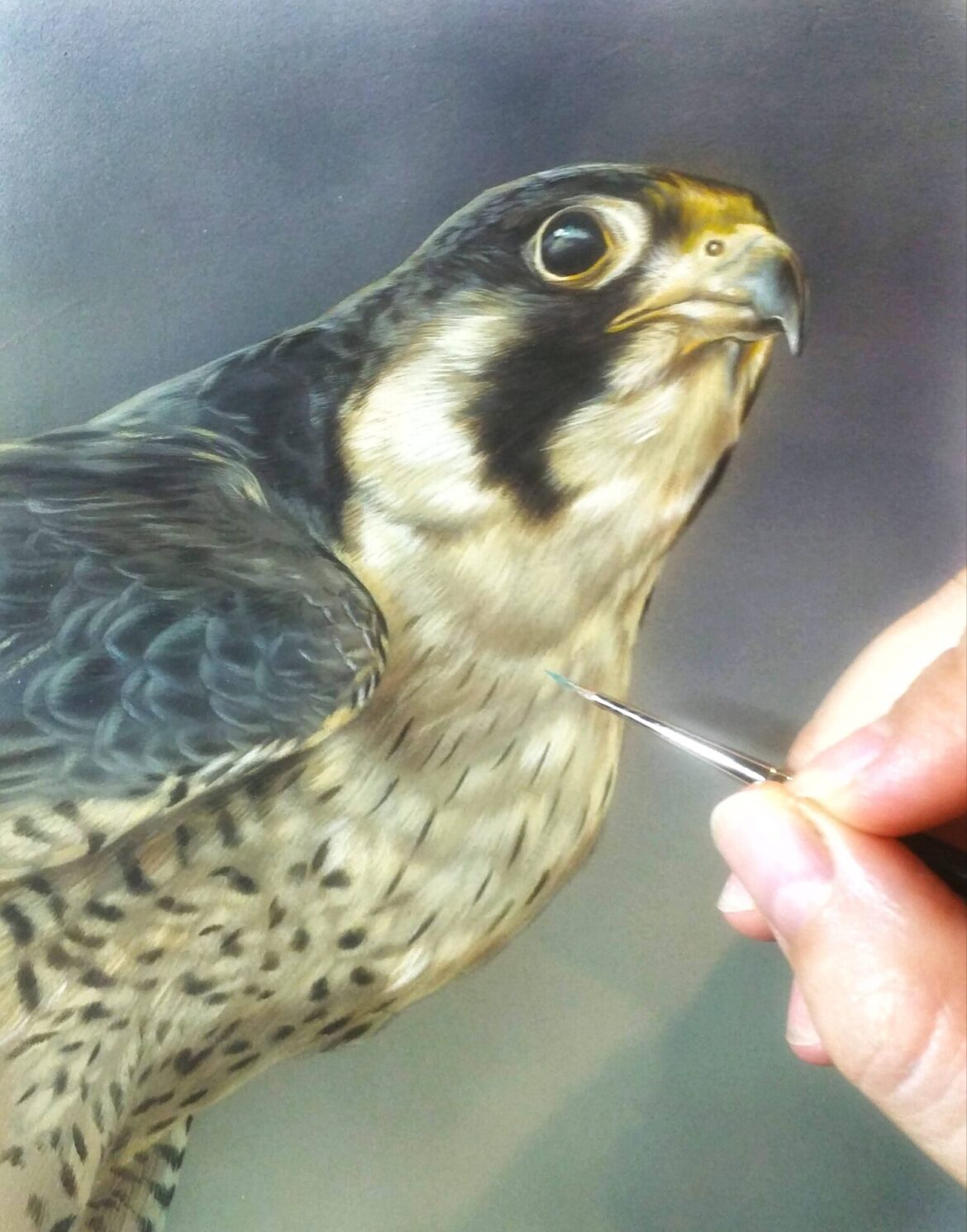
The journey of an artist is a unique and fulfilling path filled with growth, challenges, and moments of celebration. Whether you’re just starting or have been creating art for years, here are some insights to help you navigate your artistic journey: Embrace the Learning Process: Art is a lifelong journey of learning and growth. Embrace the process of continuous learning, experimentation, and improvement. Seek out new techniques, explore different mediums, and challenge yourself to step out of your comfort zone. Remember that every artwork is an opportunity to learn and grow as an artist.
Embrace Challenges: Challenges are an inherent part of the artistic journey. They push us to expand our skills, explore new ideas, and overcome creative blocks. Embrace challenges as opportunities for growth and self-discovery. Don’t be afraid to take risks and learn from both successes and failures.
Find Your Voice: Developing a unique artistic voice is an ongoing process. Explore different styles, subjects, and themes to find what resonates with you. Experiment with different techniques and mediums to develop a style that is distinctly yours. Your artistic voice is an expression of your experiences, emotions, and perspective on the world.
Seek Inspiration: Inspiration can be found in various forms and places. Surround yourself with art that inspires you, whether it’s visiting galleries, exploring online platforms, or connecting with other artists. Look beyond the art world for inspiration, such as nature, literature, or personal experiences. Seek out new experiences and perspectives to fuel your creativity.
Embrace Critique: Constructive critique is a valuable tool for growth. Seek feedback from fellow artists, mentors, or art communities. Embrace critique as an opportunity to gain new insights, identify areas for improvement, and refine your artistic skills. Remember that critique is not a reflection of your worth as an artist but a means to help you grow.
Celebrate Milestones: Celebrate your artistic milestones, no matter how small. Completing a challenging artwork, receiving positive feedback, or participating in an exhibition are all achievements worth celebrating. Take the time to acknowledge your progress and the dedication you’ve put into your craft.
Stay True to Yourself: In the midst of the artistic journey, it’s important to stay true to yourself and your artistic vision. Don’t be swayed by trends or external expectations. Trust your instincts, follow your passion, and create art that is authentic to you. Remember that your unique perspective and voice are what make your art special. Embracing the journey of an artist means embracing growth, challenges, and celebrating the successes along the way. Enjoy the process, stay curious, and continue to create art that reflects your innermost self.

- Aug 27, 2023
Embracing the Artistic Journey: Navigating an Identity Crisis in Art
Updated: Sep 12, 2023

The artistic journey is a tapestry of growth and transformation, as artists evolve and refine their creative expressions. However, this process of evolution can sometimes lead to an artistic identity crisis, where artists question the direction of their work, their unique style, and their artistic purpose. This uncertainty can be both disorienting and introspective, sparking a period of self-questioning and contemplation.
Embracing Change and Evolution:
Artists are not static beings; they are constantly evolving and responding to the world around them. Embracing change in their art is an essential part of growth, but it can also bring about moments of artistic identity crisis.
1. The Evolving Artist:
As artists gain new experiences, encounter diverse influences, and experiment with different techniques, their artistic style naturally evolves.
2. The Search for Authenticity:
Artists may feel the need to align their work with their authentic selves, leading to a period of exploration and self-discovery.
3. The Fear of Losing Direction:
During an artistic identity crisis, artists may fear losing their creative compass and question the direction they should take.
4. The Struggle with Comparison:
Comparing one's work to that of other artists can amplify feelings of self-doubt and uncertainty.
Finding Clarity in Uncertainty:
While an artistic identity crisis can be challenging, it is also an opportunity for growth and creative exploration. Here are some strategies to navigate this period of uncertainty:
1. Embrace the Process:
Acknowledge that change and evolution are natural in any artistic journey. Embrace the process of growth and allow yourself the freedom to explore new creative paths.
2. Reflect on Your Artistic Journey:
Take time to reflect on your artistic journey so far. Revisit your earlier works and observe how your style and themes have evolved.
3. Trust Your Intuition:
Follow your artistic intuition and let your heart guide you. Listen to your inner voice, for it holds the key to your true artistic identity.
4. Experiment with Abandon:
Allow yourself to experiment without judgment. Explore new mediums, styles, and techniques to reignite your creative spark.
5. Seek Inspiration from Within:
Look inward for inspiration. Connect with your emotions, experiences, and personal narratives, for they are the wellspring of authentic art.
An artistic identity crisis is not a sign of weakness or failure but a natural phase of growth and self-discovery. Embrace this period of uncertainty as an opportunity to delve deeper into your artistic essence and explore new horizons. Remember that your art is a reflection of your soul and experiences, and it will naturally evolve as you do.
Allow yourself the grace to explore and experiment, without the burden of external expectations or comparison. Trust in your artistic intuition and the uniqueness of your voice. Embrace the fluidity of your artistic identity, for it is the essence of growth and the gateway to new possibilities. As you navigate this creative journey, remember that every step is a brushstroke on the canvas of your artistic evolution, creating a beautiful mosaic that embodies your true artistic self. Embrace the process, cherish the growth, and celebrate the profound transformation that comes with being an artist.
Recent Posts
The Art of Copywriting: Elevating Your Brand with Persuasive Messaging
Uncover the art of copywriting and learn how to craft persuasive messaging that elevates your brand to new heights.
Art for Employee Engagement: Enhancing Workplace Culture with Artistic Installations
Enhance your workplace culture with art!
The Art of SEO Copywriting: How to Write Content That Ranks and Converts
Master the art of SEO copywriting with our expert tips!
Join The Art Club
Join Our Email List so You Never Miss A New Blog Post
Thanks for submitting!

- Health, Fitness & Dieting
- Psychology & Counseling

Enjoy fast, free delivery, exclusive deals, and award-winning movies & TV shows with Prime Try Prime and start saving today with fast, free delivery
Amazon Prime includes:
Fast, FREE Delivery is available to Prime members. To join, select "Try Amazon Prime and start saving today with Fast, FREE Delivery" below the Add to Cart button.
- Cardmembers earn 5% Back at Amazon.com with a Prime Credit Card.
- Unlimited Free Two-Day Delivery
- Streaming of thousands of movies and TV shows with limited ads on Prime Video.
- A Kindle book to borrow for free each month - with no due dates
- Listen to over 2 million songs and hundreds of playlists
- Unlimited photo storage with anywhere access
Important: Your credit card will NOT be charged when you start your free trial or if you cancel during the trial period. If you're happy with Amazon Prime, do nothing. At the end of the free trial, your membership will automatically upgrade to a monthly membership.

Buy new: $17.95 $17.95 FREE delivery: Friday, April 12 on orders over $35.00 shipped by Amazon. Ships from: Amazon.com Sold by: Amazon.com
Return this item for free.
Free returns are available for the shipping address you chose. You can return the item for any reason in new and unused condition: no shipping charges
- Go to your orders and start the return
- Select the return method
Buy used: $13.99
Fulfillment by Amazon (FBA) is a service we offer sellers that lets them store their products in Amazon's fulfillment centers, and we directly pack, ship, and provide customer service for these products. Something we hope you'll especially enjoy: FBA items qualify for FREE Shipping and Amazon Prime.
If you're a seller, Fulfillment by Amazon can help you grow your business. Learn more about the program.

Download the free Kindle app and start reading Kindle books instantly on your smartphone, tablet, or computer - no Kindle device required .
Read instantly on your browser with Kindle for Web.
Using your mobile phone camera - scan the code below and download the Kindle app.

Image Unavailable

- To view this video download Flash Player
Follow the author

The Artist's Journey: The Wake of the Hero's Journey and the Lifelong Pursuit of Meaning Paperback – May 26, 2018

Purchase options and add-ons
"No one's insights about the craft and journey of being an artist have guided me in the day-to-day struggle of this profession more than Steven Pressfield. Wherever you are, whatever you've been called to make, you need to read this book...and everything else he has written."
— Ryan Holiday, Bestselling Author of Ego Is the Enemy and The Obstacle Is the Way
YOU ARE AN ARTIST ... AND YOU HAVE AN ARTIST’S JOURNEY
I have a theory about the Hero’s Journey. We all have one. We have many, in fact. But our primary hero’s journey is the passage we live out, in real life, before we find our calling.
The hero’s journey ends when, like Odysseus, we return home to Ithaca, to the place from which we started.
The passage that comes next is The Artist’s Journey .
On our artist’s journey, we move past Resistance and past self-sabotage. We discover our true selves and our authentic calling, and we produce the works we were born to create.
You are an artist too—whether you realize it or not, whether you like it or not—and you have an artist’s journey. Will you live it out? Will you follow your Muse and do the work you were born to do?
Ready or not, you are called.
- Print length 192 pages
- Language English
- Publication date May 26, 2018
- Dimensions 5 x 0.48 x 8 inches
- ISBN-10 1936891549
- ISBN-13 978-1936891542
- See all details

Frequently bought together

Similar items that may ship from close to you

Editorial Reviews
About the author, product details.
- Publisher : Black Irish Entertainment LLC (May 26, 2018)
- Language : English
- Paperback : 192 pages
- ISBN-10 : 1936891549
- ISBN-13 : 978-1936891542
- Item Weight : 7.5 ounces
- Dimensions : 5 x 0.48 x 8 inches
- #284 in Popular Psychology Creativity & Genius
- #1,155 in Creativity (Books)
- #6,343 in Motivational Self-Help (Books)
About the author
Steven pressfield.
Steven Pressfield is the author of The War of Art which has sold over a millions copies globally and been translated into multiple languages. He is a master of historical fiction with Gates of Fire being on the required reading list at West Point and the the recommended reading list of the Joint Chiefs. His other books include A Man at Arms, Turning Pro, Do the Work, The Artist's Journey, Tides of War, The Legend of Bagger Vance, Last of the Amazons, Virtues of War, The Afghan Campaign, Killing Rommel, The Profession, The Lion's Gate, The Warrior Ethos, The Authentic Swing, An American Jew, Nobody Wants to Read Your Sh*t, and The Knowledge.
His debut novel, The Legend of Bagger Vance was over 30 years in the making. He hasn't stopped writing since.
Steve lives and writes in California. You can following him on IG @steven_pressfield. Sign up for his weekly writing newsletter at stevenpressfield.com
"It is one thing to study war, and another to live the warrior's life."
Customer reviews
Customer Reviews, including Product Star Ratings help customers to learn more about the product and decide whether it is the right product for them.
To calculate the overall star rating and percentage breakdown by star, we don’t use a simple average. Instead, our system considers things like how recent a review is and if the reviewer bought the item on Amazon. It also analyzed reviews to verify trustworthiness.
Reviews with images

- Sort reviews by Top reviews Most recent Top reviews
Top reviews from the United States
There was a problem filtering reviews right now. please try again later..
Top reviews from other countries
- Amazon Newsletter
- About Amazon
- Accessibility
- Sustainability
- Press Center
- Investor Relations
- Amazon Devices
- Amazon Science
- Start Selling with Amazon
- Sell apps on Amazon
- Supply to Amazon
- Protect & Build Your Brand
- Become an Affiliate
- Become a Delivery Driver
- Start a Package Delivery Business
- Advertise Your Products
- Self-Publish with Us
- Host an Amazon Hub
- › See More Ways to Make Money
- Amazon Visa
- Amazon Store Card
- Amazon Secured Card
- Amazon Business Card
- Shop with Points
- Credit Card Marketplace
- Reload Your Balance
- Amazon Currency Converter
- Your Account
- Your Orders
- Shipping Rates & Policies
- Amazon Prime
- Returns & Replacements
- Manage Your Content and Devices
- Recalls and Product Safety Alerts
- Conditions of Use
- Privacy Notice
- Consumer Health Data Privacy Disclosure
- Your Ads Privacy Choices
- International edition
- Australia edition
- Europe edition

British artist sells world's largest painting The Journey of Humanity for $62m
Sacha Jafri’s artwork is split into 70 framed sections equivalent to nearly four basketball courts
Work by British artist Sacha Jafri consisting of the world’s largest painting on canvas has been sold for $62m (£45m) at an auction in Dubai, organisers said on Tuesday.
The Journey of Humanity is split into 70 framed sections spanning 1,595.76 sq metres (17,176 sq feet) – equivalent to nearly four basketball courts.
Organisers said in a statement that the work sold for $62m, double the amount targeted, with the money going to charities helping children.
Andre Abdoune, a French national residing in Dubai, bought all 70 segments on Monday at an auction.
The work, confirmed by the Guinness World Records as the largest art canvas, had been put on display in the ballroom of the Atlantis: the Palm hotel, and was originally meant to be sold in segments.

“I come from a poor family, and I knew at times how it feels to have nothing to eat, but at least I had the love of my parents, schooling, and support,” Abdoune, who runs a crypto-currency business, told AFP.
“The painting was very powerful when I saw it, and, for me, it would have been a mistake to separate the pieces,” said the former stock trader.
Abdoune also highlighted the coronavirus pandemic, noting how it had taken a toll on children around the world.
“We have to react, so if I can bring my little piece in the puzzle, I’m happy,” he said.
Jafri had aimed to raise $30m to fund health, sanitation and education initiatives for children in impoverished parts of the world.
The 44-year-old contemporary artist is hoping his painting will spark a humanitarian movement.
Children from 140 countries submitted artwork online to be included in Jafri’s creation, which was completed at the end of September.
- Guinness World Records


Bournemouth man sets Guinness World Record as longest-serving lifeguard

Eiffel Tower crowned as world’s tallest matchstick building after record U-turn

British soldier claims record for fastest woman to ski alone to south pole

Gales forecast as adventurer reaches halfway point in bid for Rockall record

178 Hirokazu Tanakas set new namesake-gathering world record

‘Plenty of chocolate bars’: first woman swims from Land’s End to John o’Groats

‘Absolutely amazing’: Teenager becomes youngest person to fly solo around world

Man seeks to break world record for most bungee jumps in 24 hours

Teenage pilot aims to break sister’s round-the-world solo flight record

Around the world in 155 days: the teenager who flew into record books
Most viewed.
A Journey to the Oldest Cave Paintings in the World
The discovery in a remote part of Indonesia has scholars rethinking the origins of art—and of humanity
Jo Marchant; Photographs by Justin Mott
/https://tf-cmsv2-smithsonianmag-media.s3.amazonaws.com/filer/cf/a2/cfa2b864-1c71-4b8e-9a1a-aa23b53b7517/janfeb2016_f09_indonesiacavepaintings.jpg)
I struggle to keep my footing on a narrow ridge of earth snaking between flooded fields of rice. The stalks, almost ready to harvest, ripple in the breeze, giving the valley the appearance of a shimmering green sea. In the distance, steep limestone hills rise from the ground, perhaps 400 feet tall, the remains of an ancient coral reef. Rivers have eroded the landscape over millions of years, leaving behind a flat plain interrupted by these bizarre towers, called karsts, which are full of holes, channels and interconnecting caves carved by water seeping through the rock.
We’re on the island of Sulawesi, in Indonesia, an hour’s drive north of the bustling port of Makassar. We approach the nearest karst undeterred by a group of large black macaques that screech at us from trees high on the cliff and climb a bamboo ladder through ferns to a cave called Leang Timpuseng. Inside, the usual sounds of everyday life here—cows, roosters, passing motorbikes—are barely audible through the insistent chirping of insects and birds. The cave is cramped and awkward, and rocks crowd into the space, giving the feeling that it might close up at any moment. But its modest appearance can’t diminish my excitement: I know this place is host to something magical, something I’ve traveled nearly 8,000 miles to see.
Scattered on the walls are stencils, human hands outlined against a background of red paint. Though faded, they are stark and evocative, a thrilling message from the distant past. My companion, Maxime Aubert, directs me to a narrow semicircular alcove, like the apse of a cathedral, and I crane my neck to a spot near the ceiling a few feet above my head. Just visible on darkened grayish rock is a seemingly abstract pattern of red lines.
Then my eyes focus and the lines coalesce into a figure, an animal with a large, bulbous body, stick legs and a diminutive head: a babirusa, or pig-deer, once common in these valleys. Aubert points out its neatly sketched features in admiration. “Look, there’s a line to represent the ground,” he says. “There are no tusks—it’s female. And there’s a curly tail at the back.”
This ghostly babirusa has been known to locals for decades, but it wasn’t until Aubert, a geochemist and archaeologist, used a technique he developed to date the painting that its importance was revealed. He found that it is staggeringly ancient: at least 35,400 years old. That likely makes it the oldest-known example of figurative art anywhere in the world—the world’s very first picture.
It’s among more than a dozen other dated cave paintings on Sulawesi that now rival the earliest cave art in Spain and France, long believed to be the oldest on earth.
The findings made headlines around the world when Aubert and his colleagues announced them in late 2014, and the implications are revolutionary. They smash our most common ideas about the origins of art and force us to embrace a far richer picture of how and where our species first awoke.
Hidden away in a damp cave on the “other” side of the world, this curly-tailed creature is our closest link yet to the moment when the human mind, with its unique capacity for imagination and symbolism, switched on.
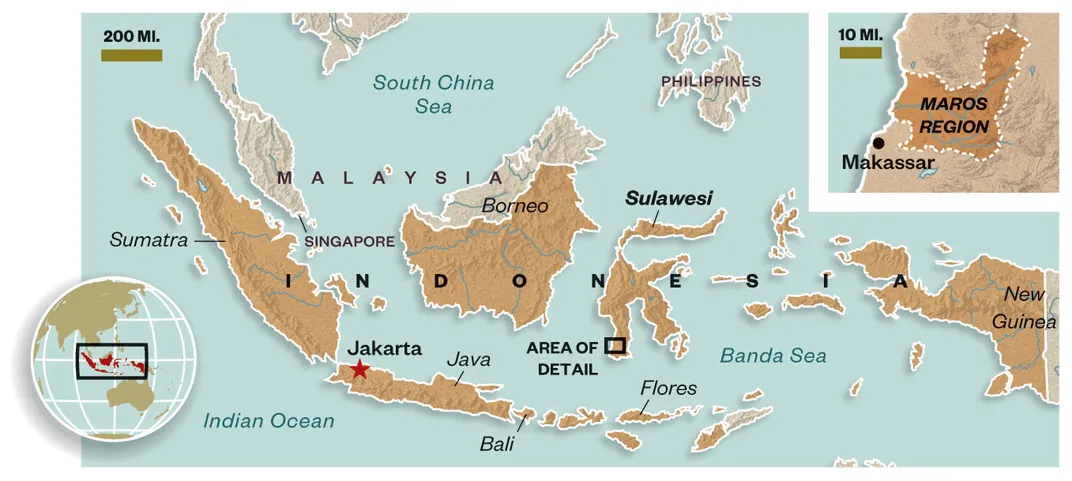
Who were the first “people,” who saw and interpreted the world as we do? Studies of genes and fossils agree that Homo sapiens evolved in Africa 200,000 years ago. But although these earliest humans looked like us, it’s not clear they thought like us.
Intellectual breakthroughs in human evolution such as tool-making were mastered by other hominin species more than a million years ago. What sets us apart is our ability to think and plan for the future, and to remember and learn from the past—what theorists of early human cognition call “higher order consciousness.”
Such sophisticated thinking was a huge competitive advantage, helping us to cooperate, survive in harsh environments and colonize new lands. It also opened the door to imaginary realms, spirit worlds and a host of intellectual and emotional connections that infused our lives with meaning beyond the basic impulse to survive. And because it enabled symbolic thinking—our ability to let one thing stand for another—it allowed people to make visual representations of things that they could remember and imagine. “We couldn’t conceive of art, or conceive of the value of art, until we had higher order consciousness,” says Benjamin Smith, a rock art scholar at the University of Western Australia. In that sense, ancient art is a marker for this cognitive shift: Find early paintings, particularly figurative representations like animals, and you’ve found evidence for the modern human mind.
Until Aubert went to Sulawesi, the oldest dated art was firmly in Europe. The spectacular lions and rhinos of Chauvet Cave, in southeastern France, are commonly thought to be around 30,000 to 32,000 years old, and mammoth-ivory figurines found in Germany correspond to roughly the same time. Representational pictures or sculptures don’t appear elsewhere until thousands of years afterward. So it has long been assumed that sophisticated abstract thinking, perhaps unlocked by a lucky genetic mutation, emerged in Europe shortly after modern humans arrived there about 40,000 years ago. Once Europeans started to paint, their skills, and their human genius, must have then spread around the world.
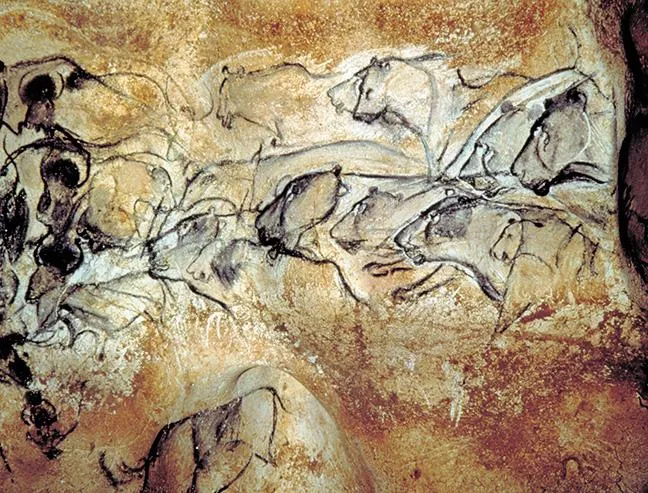
But experts now challenge that standard view. Archaeologists in South Africa have found that the pigment ocher was used in caves 164,000 years ago. They have also unearthed deliberately pierced shells with marks suggesting they were strung like jewelry, as well as chunks of ocher, one engraved with a zigzag design—hinting that the capacity for art was present long before humans left Africa. Still, the evidence is frustratingly indirect. Perhaps the ocher wasn’t for painting but for mosquito repellent. And the engravings could have been one-offs, doodles with no symbolic meaning, says Wil Roebroeks, an expert in the archaeology of early humans, of Leiden University in the Netherlands. Other extinct hominin species have left similarly inconclusive artifacts.
By contrast, the gorgeous animal cave paintings in Europe represent a consistent tradition. The seeds of artistic creativity may have been sown earlier, but many scholars celebrate Europe as the place where it burst, full-fledged, into view. Before Chauvet and El Castillo, the famous art-filled cave in northern Spain, “we don’t have anything that smacks of figurative art,” says Roebroeks. “But from that point on,” he continues, “you have the full human package. Humans were more or less comparable to you and me.”
Yet the lack of older paintings may not reflect the true history of rock art so much as the fact that they can be very difficult to date. Radiocarbon dating, the kind used to determine the age of the charcoal paintings at Chauvet, is based on the decay of the radioactive isotope carbon-14 and works only on organic remains. It’s no good for studying inorganic pigments like ocher, a form of iron oxide used frequently in ancient cave paintings.
This is where Aubert comes in. Instead of analyzing pigment from the paintings directly, he wanted to date the rock they sat on, by measuring radioactive uranium, which is present in many rocks in trace amounts. Uranium decays into thorium at a known rate, so comparing the ratio of these two elements in a sample reveals its age; the greater the proportion of thorium, the older the sample. The technique, known as uranium series dating, was used to determine that zircon crystals from Western Australia were more than four billion years old, proving Earth’s minimum age. But it can also date newer limestone formations, including stalactites and stalagmites, known collectively as speleothems, which form in caves as water seeps or flows through soluble bedrock.
Aubert, who grew up in Lévis, Canada, and says he has been interested in archaeology and rock art since childhood, thought to date rock formations at a minute scale directly above and below ancient paintings, to work out their minimum and maximum age. To do this would require analyzing almost impossibly thin layers cut from a cave wall—less than a millimeter thick. Then a PhD student at the Australian National University in Canberra, Aubert had access to a state-of-the-art spectrometer, and he started to experiment with the machine, to see if he could accurately date such tiny samples.
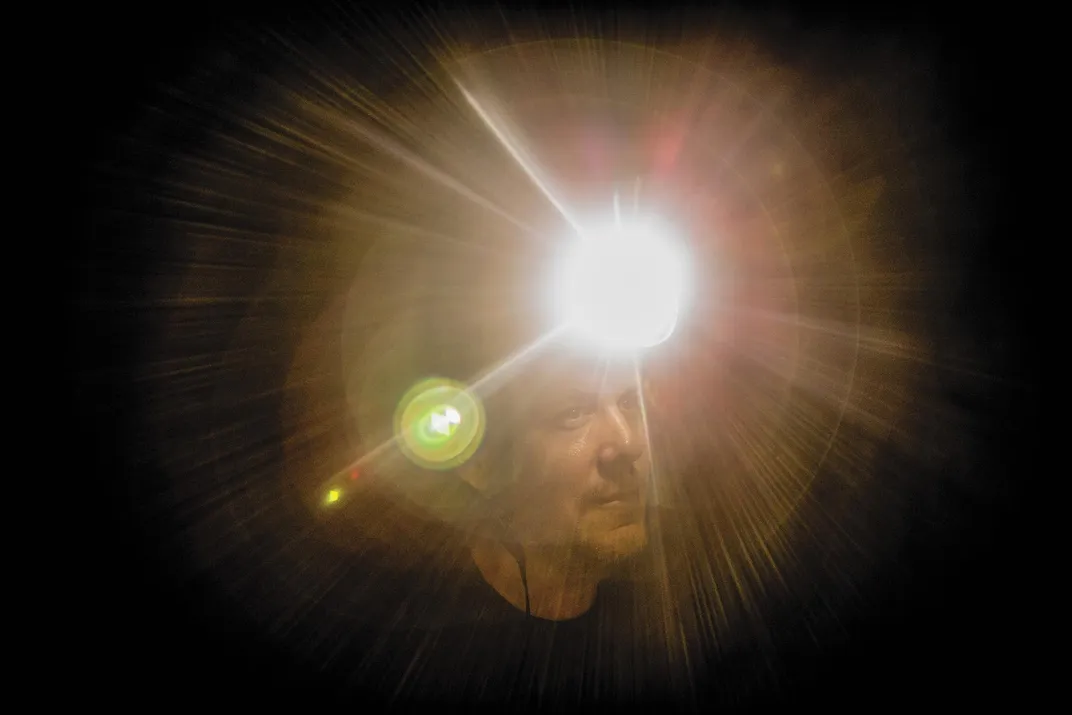
Within a few years, Adam Brumm, an archaeologist at the University of Wollongong, where Aubert had received a postdoctoral fellowship—today they are both based at Griffith University—started digging in caves in Sulawesi. Brumm was working with the late Mike Morwood, co-discoverer of the diminutive hominin Homo floresiensis , which once lived on the nearby Indonesian island of Flores. The evolutionary origins of this so-called “hobbit” remain a mystery, but, to have reached Flores from mainland Southeast Asia, its ancestors must have passed through Sulawesi. Brumm hoped to find them.
As they worked, Brumm and his Indonesian colleagues were struck by the hand stencils and animal images that surrounded them. The standard view was that Neolithic farmers or other Stone Age people made the markings no more than 5,000 years ago—such markings on relatively exposed rock in a tropical environment, it was thought, couldn’t have lasted longer than that without eroding away. But the archaeological evidence showed that modern humans had arrived on Sulawesi at least 35,000 years ago. Could some of the paintings be older? “We were drinking palm wine in the evenings, talking about the rock art and how we might date it,” Brumm recalls. And it dawned on him: Aubert’s new method seemed perfect.
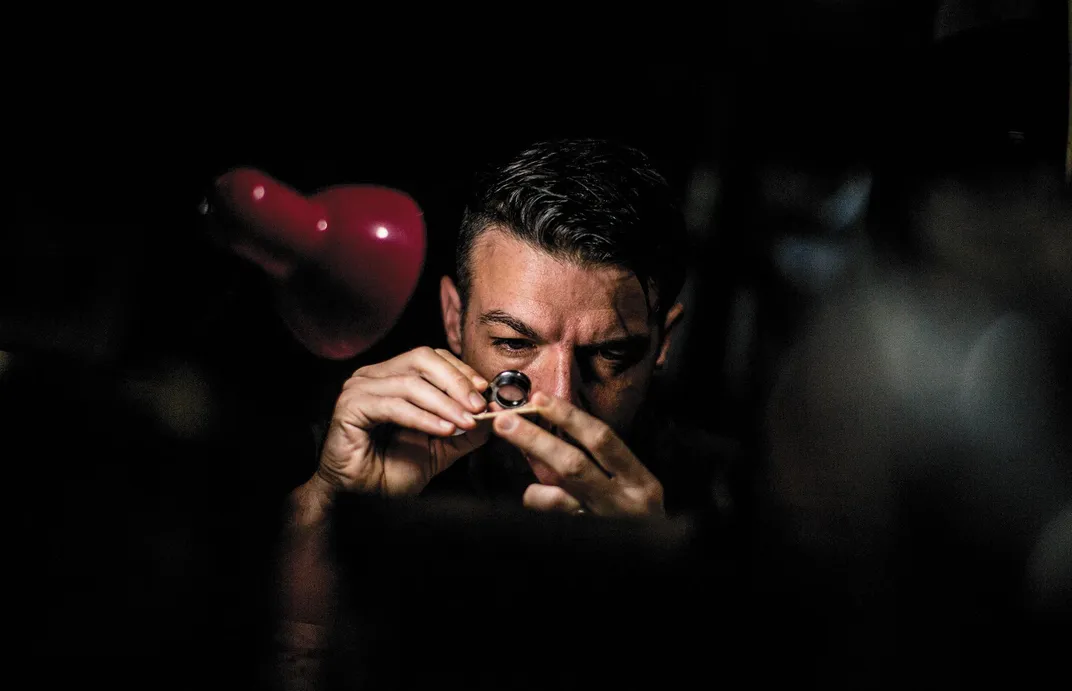
After that, Brumm looked for paintings partly obscured by speleothems every chance he got. “One day off, I visited Leang Jarie,” he says. Leang Jarie means “Cave of Fingers,” named for the dozens of stencils decorating its walls. Like Leang Timpuseng, it is covered by small growths of white minerals formed by the evaporation of seeping or dripping water, which are nicknamed “cave popcorn.” “I walked in and bang , I saw these things. The whole ceiling was covered with popcorn, and I could see bits of hand stencils in between,” recalls Brumm. As soon as he got home, he told Aubert to come to Sulawesi.
Aubert spent a week the next summer touring the region by motorbike. He took samples from five paintings partly covered by popcorn, each time using a diamond-tipped drill to cut a small square out of the rock, about 1.5 centimeters across and a few millimeters deep.
Back in Australia, he spent weeks painstakingly grinding the rock samples into thin layers before separating out the uranium and thorium in each one. “You collect the powder, then remove another layer, then collect the powder,” Aubert says. “You’re trying to get as close as possible to the paint layer.” Then he drove from Wollongong to Canberra to analyze his samples using the mass spectrometer, sleeping in his van outside the lab so he could work as many hours as possible, to minimize the number of days he needed on the expensive machine. Unable to get funding for the project, he had to pay for his flight to Sulawesi—and for the analysis—himself. “I was totally broke,“ he says.
The very first age Aubert calculated was for a hand stencil from the Cave of Fingers. “I thought, ‘Oh, shit,’” he says. “So I calculated it again.” Then he called Brumm.
“I couldn’t make sense of what he was saying,” Brumm recalls. “He blurted out, ‘35,000!’ I was stunned. I said, are you sure? I had the feeling immediately that this was going to be big.”
The caves we visit in Sulawesi are astonishing in their variety. They range from small rock shelters to huge caverns inhabited by venomous spiders and large bats. Everywhere there is evidence of how water has formed and changed these spaces. The rock is bubbling and dynamic, often glistening wet. It erupts into shapes resembling skulls, jellyfish, waterfalls and chandeliers. As well as familiar stalactites and stalagmites, there are columns, curtains, steps and terraces—and popcorn everywhere. It grows like barnacles on the ceilings and walls.
We’re joined by Muhammad Ramli, an archaeologist at the Center for the Preservation of Archaeological Heritage, in Makassar. Ramli knows the art in these caves intimately. The first one he visited, as a student in 1981, was a small site called Leang Kassi. He remembers it well, he says, not least because while staying overnight in the cave he was captured by local villagers who thought he was a headhunter. Ramli is now a portly but energetic 55-year-old with a wide-brimmed explorer’s hat and a collection of T-shirts with messages like “Save our heritage” and “Keep calm and visit museums.” He has cataloged more than 120 rock art sites in this region, and has established a system of gates and guards to protect the caves from damage and graffiti.
Almost all of the markings he shows me, in ocher and charcoal, appear in relatively exposed areas, lit by the sun. And they were apparently made by all members of the community. At one site, I climb a fig tree into a small, high chamber and am rewarded by the outline of a hand so small it could belong to my 2-year-old son. At another, hands are lined up in two horizontal tracks, all with fingers pointing to the left. Elsewhere there are hands with slender, pointed digits possibly created by overlapping one stencil with another; with painted palm lines; and with fingers that are bent or missing.
There’s still a tradition on Sulawesi of mixing rice powder with water to make a handprint on the central pillar of a new house, Ramli explains, to protect against evil spirits. “It’s a symbol of strength,” he says. “Maybe the prehistoric man thought like that too.” And on the nearby island of Papua, he says, some people express their grief when a loved one dies by cutting off a finger. Perhaps, he suggests, the stencils with missing fingers indicate that this practice too has ancient origins.
Paul Taçon, an expert in rock art at Griffith University, notes that the hand stencils are similar to designs created until recently in northern Australia. Aboriginal Australian elders he has interviewed explain that their stencils are intended to express connection to a particular place, to say: “I was here. This is my home.” The Sulawesi hand stencils “were probably made for similar reasons,” he says. Taçon believes that once the leap to rock art was made, a new cognitive path—the ability to retain complex information over time—had been set. “That was a major change,” he says.
There are two main phases of artwork in these caves. A series of black charcoal drawings—geometric shapes and stick figures including animals such as roosters and dogs, which were introduced to Sulawesi in the last few thousand years—haven’t been dated but presumably could not have been made before the arrival of these species.
Alongside these are red (and occasionally purplish-black) paintings that look very different: hand stencils and animals, including the babirusa in Leang Timpuseng, and other species endemic to this island, such as the warty pig. These are the paintings dated by Aubert and his colleagues, whose paper, published in Nature in October 2014 , ultimately included more than 50 dates from 14 paintings. Most ancient of all was a hand stencil (right beside the record-breaking babirusa) with a minimum age of 39,900 years—making it the oldest-known stencil anywhere, and just 900 years shy of the world’s oldest-known cave painting of any kind, a simple red disk at El Castillo. The youngest stencil was dated to no more than 27,200 years ago, showing that this artistic tradition lasted largely unchanged on Sulawesi for at least 13 millennia.
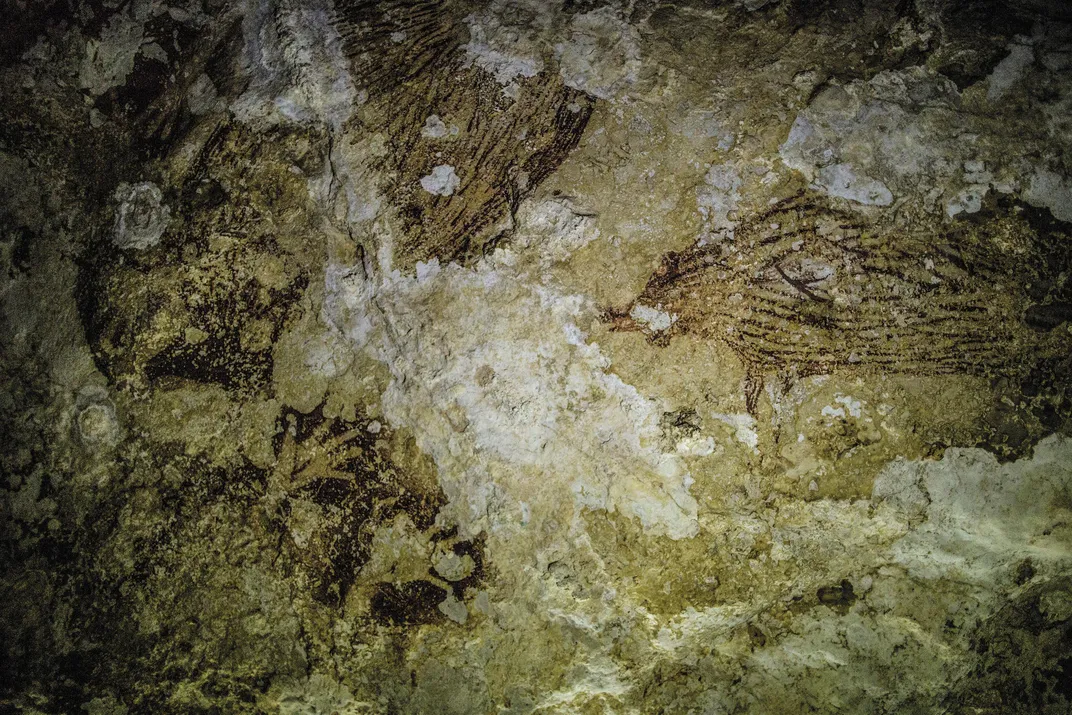
The findings obliterated what we thought we knew about the birth of human creativity. At a minimum, they proved once and for all that art did not arise in Europe. By the time the shapes of hands and horses began to adorn the caves of France and Spain, people here were already decorating their own walls. But if Europeans didn’t invent these art forms, who did?
On that, experts are divided. Taçon doesn’t rule out the possibility that art might have arisen independently in different parts of the world after modern humans left Africa. He points out that although hand stencils are common in Europe, Asia and Australia, they are rarely seen in Africa at any time. “When you venture to new lands, there are all kinds of challenges relating to the new environment,” he says. You have to find your way around, and deal with strange plants, predators and prey. Perhaps people in Africa were already decorating their bodies, or making quick drawings in the ground. But with rock markings, the migrants could signpost unfamiliar landscapes and stamp their identity onto new territories.
Yet there are thought-provoking similarities between the earliest Sulawesian and European figurative art—the animal paintings are detailed and naturalistic, with skillfully drawn lines to give the impression of a babirusa’s fur or, in Europe, the mane of a bucking horse. Taçon believes that the technical parallels “suggest that painting naturalistic animals is part of a shared hunter-gatherer practice rather than a tradition of any particular culture.” In other words, there may be something about such a lifestyle that provoked a common practice, rather than its arising from a single group.
But Smith, of the University of Western Australia, argues that the similarities—ocher use, hand stenciling and lifelike animals—can’t be coincidental. He thinks these techniques must have arisen in Africa before the waves of migrations off the continent began. It’s a view in common with many experts. “My bet would be that this was in the rucksack of the first colonizers,” adds Wil Roebroeks, of Leiden University.
The eminent French prehistorian Jean Clottes believes that techniques such as stenciling may well have developed separately in different groups, including those who eventually settled on Sulawesi. One of the world’s most respected authorities on cave art, Clottes led research on Chauvet Cave that helped to fuel the idea of a European “human revolution.” “Why shouldn’t they make hand stencils if they wanted to?” he asks, when I reach him at his home in Foix, France. “People reinvent things all the time.” But although he is eager to see Aubert’s results replicated by other researchers, he feels that what many suspected from the pierced shells and carved ocher chunks found in Africa is now all but inescapable: Far from being a late development, the sparks of artistic creativity can be traced back to our earliest ancestors on that continent. Wherever you find modern humans, he believes, you’ll find art.
In a cavern known locally as Mountain-Tunnel Cave, buckets, a wheelbarrow and countless bags of clay surround a neatly dug trench, five meters long by three meters deep, where Adam Brumm is overseeing a dig that is revealing how the island’s early artists lived.
People arrived on Sulawesi as part of a wave of migration from east Africa that started around 60,000 years ago, likely traveling across the Red Sea and the Arabian Peninsula to present-day India, Southeast Asia and Borneo, which at the time was part of the mainland. To reach Sulawesi, which has always been an island, they would have needed boats or rafts to cross a minimum of 60 miles of ocean. Although human remains from this period haven’t yet been found on Sulawesi, the island’s first inhabitants are thought to have been closely related to the first people to colonize Australia around 50,000 years ago. “They probably looked broadly similar to Aboriginal or Papuan people today,” says Brumm.
Brumm and his team have unearthed evidence of fire-building, hearths and precisely crafted stone tools, which may have been used to make weapons for hunting. Yet while the inhabitants of this cave sometimes hunted large animals such as wild boar, the archaeological remains show that they mostly ate freshwater shellfish and an animal known as the Sulawesi bear cuscus—a slow-moving tree-dwelling marsupial with a long, prehensile tail.
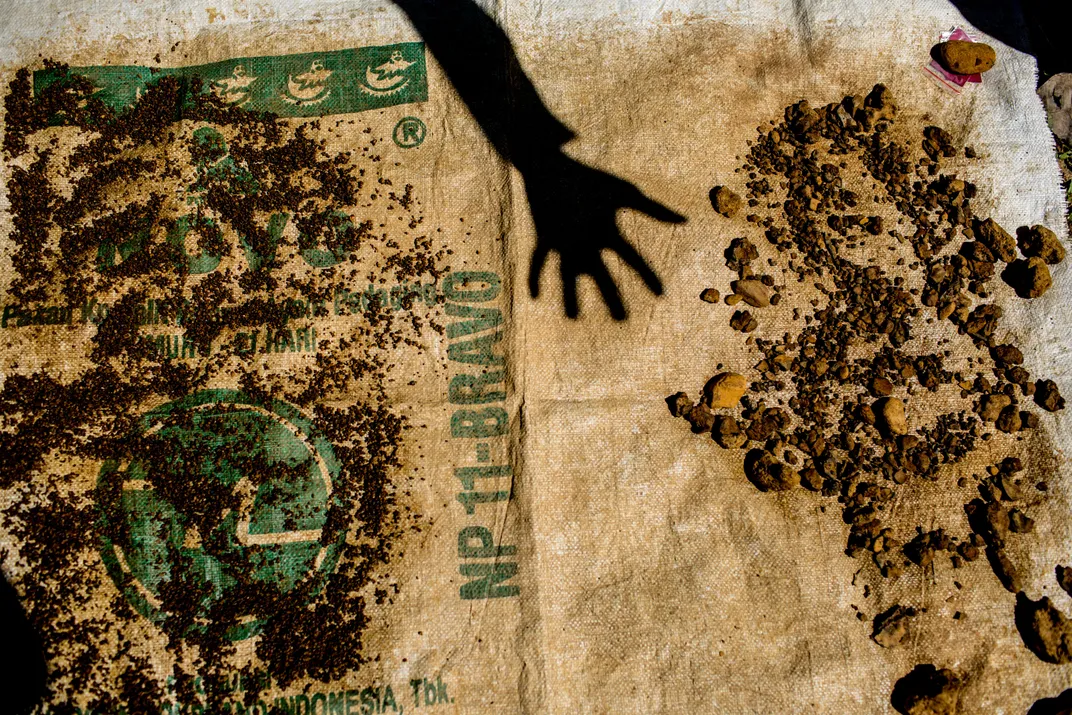
The French anthropologist Claude Lévi-Strauss famously argued in 1962 that primitive peoples chose to identify with and represent animals not because they were “good to eat” but because they were “good to think.” For ice age European cave painters, horses, rhinos, mammoths and lions were less important as dinner than as inspiration. Ancient Sulawesians, it seems, were likewise moved to depict larger, more daunting and impressive animals than the ones they frequently ate.
The hunt is now on for even older paintings that might take us ever closer to the moment of our species’ awakening. Aubert is collecting samples of limestone from painted caves elsewhere in Asia, including in Borneo, along the route that migrants would have taken to Sulawesi. And he and Smith are also independently working to develop new techniques to study other types of caves, including sandstone sites common in Australia and Africa. Sandstone doesn’t form cave popcorn, but the rock forms a “silica skin” that can be dated.
Smith, working with colleagues at several institutions, is just getting the first results from an analysis of paintings and engravings in the Kimberley, an area in northwestern Australia reached by modern humans at least 50,000 years ago. “The expectation is that we may see some very exciting early dates,” Smith says. “It wouldn’t surprise me at all if pretty quickly we get a whole mass of dates that are earlier than in Europe.” And scholars now talk excitedly about the prospect of analyzing cave paintings in Africa. “99.9 percent of rock art is undated,” says Smith, citing, as an example, ocher representations of crocodiles and hippos found in the Sahara, often on sandstone and granite. “The conventional date on those would be 15,000 to 20,000 years old,” he says. “But there’s no reason they couldn’t be older.”
As the origins of art extend backward, we’ll have to revise our often localized ideas of what prompted such aesthetic expression in the first place. It has previously been suggested that Europe’s harsh northern climate necessitated strong social bonds, which in turn nudged the development of language and art. Or that competition with Neanderthals, present in Europe until around 25,000 years ago, pushed modern humans to express their identity by painting on cave walls—ancient hominin flag-planting. “Those arguments fall away,” says Smith, “because that wasn’t where it happened.”
Clottes has championed the theory that in Europe, where art was hidden deep inside dark chambers, the main function of cave paintings was to communicate with the spirit world. Smith is likewise convinced that in Africa, spiritual beliefs drove the very first art. He cites Rhino Cave in Botswana, where archaeologists have found that 65,000 to 70,000 years ago people sacrificed carefully made spearheads by burning or smashing them in front of a large rock panel carved with hundreds of circular holes. “We can be sure that in instances like that, they believed in some sort of spiritual force,” says Smith. “And they believed that art, and ritual in relation to art, could affect those spiritual forces for their own benefit. They’re not just doing it to create pretty pictures. They’re doing it because they’re communicating with the spirits of the land.”
In Mountain-Tunnel Cave, which has hand stencils and abundant traces of paint on the walls, Brumm is now also finding the early artists’ materials. In strata dated to around the same time as nearby stencils, he says, “there’s a major spike in ocher.” So far, his team has found stone tools with ocher smeared over the edges and golf ball-size ocher chunks with scrape marks. There are also scattered fragments, probably dropped and splashed when the artists ground up their ocher before mixing it with water—enough, in fact, that this entire slice of earth is stained cherry red.
Brumm says this layer of habitation stretches back at least 28,000 years, and he is in the process of analyzing older layers, using radiocarbon dating for the organic remains and uranium series dating of horizontal stalagmites that run through the sediment.
He calls this “a crucial opportunity.” For the first time in this part of the world, he says, “we’re linking the buried evidence with the rock art.” What that evidence shows is that on this island, at least, cave art wasn’t always an occasional activity carried out in remote, sacred spaces. If religious belief played a part, it was entwined with everyday life. In the middle of this cave floor, the first Sulawesians sat together around the fire to cook, eat, make tools—and to mix paint.
In a small hidden valley Aubert, Ramli and I walk across fields of rice in the early morning. Dragonflies glitter in the sun. At the far edge, we climb a set of steps high up a cliff to a breathtaking view and a cavernous entrance hall inhabited by swallows.
In a low chamber inside, pigs amble across the ceiling. Two appear to be mating—unique for cave art, Ramli points out. Another, with a swollen belly, might be pregnant. He speculates that this is a story of regeneration, the stuff of myth.
Past the pigs, a passageway leads to a deeper chamber where, at head height, there is a panel of well-preserved stencils including the forearms, which look as if they are reaching right out of the wall. Rock art is “one of the most intimate archives of the past,” Aubert once told me. “It instills a sense of wonder. We want to know: Who made it? Why?” The animal paintings are technically impressive, but for me the stencils inspire the strongest emotional connection. Forty thousand years later, standing here in the torchlight feels like witnessing a spark or a birth, a sign of something new in the universe. Outlined by splattered paint, fingers spread wide, the marks look insistent and alive.
Whatever was meant by these stencils, there can be no stronger message in viewing them: We are human. We are here. I raise my own hand to meet one, fingers hovering an inch above the ancient outline. It fits perfectly.
Related Reads
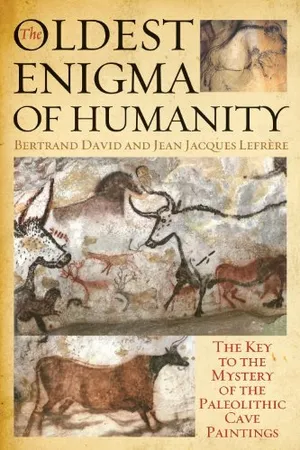
The Oldest Enigma of Humanity
Get the latest History stories in your inbox?
Click to visit our Privacy Statement .
/https://tf-cmsv2-smithsonianmag-media.s3.amazonaws.com/accounts/headshot/Jo.png)
Jo Marchant | | READ MORE
Jo Marchant is an award-winning science journalist and former editor at New Scientist and Nature . She is the author of The Human Cosmos: Civilization and the Stars and The Shadow King: The Bizarre Afterlife of King Tut's Mummy . Website: jomarchant.com
Justin Mott | READ MORE
Justin Mott is a widely published, award-winning photographer. He is based in Southeast Asia, and has worked with the New York Times , TIME , Newsweek , The Guardian , and more.

- Art Movements

Exploring Art: Unpacking the Artist’s Journey and Masterpieces

Embarking on a chimerical journey through the realm of art, we shall quest towards a profound comprehension of this vibrant tapestry of human creativity and expression. The etchings on our pathway shall chart the course of the creative process, an intricate maze, as it blossoms through the mindscape of artists into masterpieces that conjure awe and introspection. The sceptre of art has served not merely as a conduit of beauty, but also as a chronicle of our shared fortunes, etching into its canvas the tale of human history and culture. As we meander through the epochs, we shall illuminate upon transformative art movements that have ebbed and flowed, shaping the present artistic landscape. Simultaneously, we shall endeavour to understand the whispers of artists’ souls, immortalised within the strokes of their creations, and the consequent symbiosis between personal experiences and artistic oeuvre.
Understanding the Creative Process
The acts of artistry: delving into the creative process.
Venturing into the hidden enclaves of an artist’s mind can be akin to navigating the labyrinth of Minos – fascinating, enlightening, and peppered unpredictably with both divine and devilish inspiration. The world through an artist’s eyes seethes with possibilities, forming an elaborate dance of colour, shape, and contours that pulse with the rhythm of creation. Yet, how exactly do artists steer this sumptuous procession of the senses?
The creative process often springs from a well of artistic intent, blooming like a lotus from the subconscious mind. These embryonic impulses – a vivacious colour, a haunting melody, or a striking line from a poem – are the spark that sets the creative wheel churning.
Related Posts

Wartime Art History

Frida Kahlo & Magical Realism

Mythology in Ancient Art

Take a painter, for example. No canvas is ever approached with an ’empty’ mind. There’s always a seed, a kernel of inspiration that might not be visible in the finished work, but it serves as the hidden catalyst. Even our beloved ‘accidents’ are a clever dance between intention and what is allowed to freely form under the liberated paintbrush.
Equally important is the ability to balance self-expression and the intended message. A sculpture might depict a thousand emotions, each carefully embedded into its bronze façade. Still, the power of its statement depends on the delicate equilibrium between the artist’s profound feelings and the thoughts they wish to communicate through their art.
The artist is often both architect and archaeologist, simultaneously constructing and excavating personal history, sentiments, and experiences. The ultimate piece doesn’t merely replicate the physical world; rather, it serves as an intimate voyage through the artist’s inner cosmos.
On a deeper level, the artistic journey traverses the path of self-discovery and self-mastery. Intricately weaving together fragments of dreams and reality, the artist undertakes a brave venture within themselves. This deep communion with the self is elegantly reflected in the final piece, delineating a story rich with the ardent inklings of heart and soul.
Understanding media and materials is also a cornerstone of the creative process. Painters comprehend the nuanced language of pigments and brushes, while sculptors read the veiled whispers etched in marble and wood. The choice and manipulation of material resonate with the symbiotic relationship between the artist and their chosen craft, enriching the narrative that is playfully hidden within each creative composition.
Mastering technique is, of course, another vital aspect. Hours, days, even years of refining cannot be understated. Yet, it should be remembered that technique, while incredibly valuable, is but a tool. The true power rests with the spirit that wields it. Art is a journey, not a destination, and the value of an art piece often lies more in its transformative journey, rather than the final outcome.
Art, in essence, is a beautifully balanced act of performative alchemy – a wondrous fusion of emotion, technique, and medium, diligently shaped by the sculptor’s skill, the painter’s eye, the musician’s melody, the writer’s pen. It is a multi-dimensional language, singing its harmonious symphony with every stroke, chisel, note, and word.
The creative process, far from being a mystery, is the heart of artistic exploration and discovery. It is the curious, fearless plunge into the vast ocean of creative potential that resides within everyone. It is the daring dance along the tightrope of imagination, poised beautifully between the abyss of the unknown and the safe ground of familiarity. And it is these brave, bold artists who dare to walk this line who fill our world with colour, beauty, and soul-stirring insight.

The Role of Art in History
The confluence of art and history: recording and interpreting the past through a creative lens.
In our quest to understand the past, we often turn to written records. But words, with their inherent limitations, can only offer a slender slice of that bygone reality. Another, more intuitive path to comprehending our history, lies through the expressive and evocative realm of art—a language that transcends the barriers of language and time, narrating tales that would otherwise remain untold.
Analysing art produced during a particular era helps peel back the layers of that time. Since artists are not just creators but also documenters of their reality, their work becomes a time capsule, preserving the essence of their epoch. They gift to future generations a fresh perspective on historical events, far from the detached and emotionless chronicles that typify the majority of written accounts.
Moreover, art chronicles not just the outward occurrences but the emotional fabric of the society, revealing the nuanced socio-cultural-political shifts in attitudes, biases, and beliefs. Which lens could offer a more insightful view of the French Revolution—the words of an academic historian or the stirring canvas of Delacroix’s ‘Liberty Leading the People’? Invariably, art captures the soul of an epoch in a way words often fail to.
Further, art allows for interpretation, leaving an open-ended narrative that differs from viewer to viewer, generation to generation. While facts and figures elevate objectivity, the subjective art form enables a more empathetic understanding of the past. Within a single piece, multiple viewpoints can co-exist, catering to diverse perspectives and highlighting contradictions. This inherent subjectivity extends the dialogue, sparking critical thinking and fostering a more engaging relationship with our past.
It’s fascinating how art serves as a bridge between the past and the present. Today’s digital age has made art more democratic and accessible, encouraging a broader audience to engage with history on a more profound and personal level. Platforms hosting digital art archives enable virtual visitors to delve into past art movements, trace historical narratives and even engage with masterpieces up-close—an impossibility within the rigid boundaries of physical museums.
In conclusion, art plays a pivotal role in recording and interpreting historical events, acting as a rich, layered, and evocative supplement to written accounts. By engaging with art, we enter a time machine, briefly living the past through the mind and heart of the artists who were our bygone compatriots. So, let’s don artists’ spectacles and embark on this captivating journey through time, filled with an intricate tapestry woven from the threads of human emotion, creativity, imagination, and historical perspective.

Photo by rhondak on Unsplash
Major Art Movements and Their Influence
Delving into the captivating vista of art history, significant evolutions and revolutions emerge, shaping the future contours of creative culture. Much like fleeting clouds that morph and change against the wide expanse of sky, art too, is an ever-evolving enigma that reflects the zeitgeist of different eras. From exquisitely detailed Renaissance paintings to the chaotic yet harmonious strokes of Abstract Expressionism, these stylistic shifts carve the trajectory of art, leaving profound impacts on the contemporary art landscape.
A logical starting point in our artistic journey are the stringent rules and formal compositions of the Classical period. Artists were strictly trained to craft works displaying perfect proportions and perspective. Mastery was key, and artists were revered for their logical, idealistic representations. Our current day value for technical precision has its roots in the drill and discipline espoused by this era.
Morphing from these rigid strictures, the Romantic age brought a refreshing breath of emotional resonance. Romantic artists strove to capture fleeting moods and atmospheric scenes, making way for the importance of emotional and intellectual interpretation that is so intrinsic to today’s art scene.
This amorphous emotional quality was further heightened with the advent of Impressionism. Shattering the shackles of realism, this progressive seismic shift prioritised the artist’s perception over literal representation. Evanescent moments were sculpted with broad strokes and a soft riot of colours, paving way for today’s interpretative artistic climate, allowing for individual experiences and views to drastically shape one’s appreciation of a work.
Following the free-form tide led us to Cubism, a Picasso-led rebellion that fragmented form, tossing traditional perspective out of the window. Art was to be viewed from multiple angles simultaneously. Breaking the two-dimensional barrier, Cubism instated a daring possibility of multidimensional reality in art. This is vividly evident in modern mixed media and digital art formats that explore art outside the confines of a traditional canvas.
Expressionism and Surrealism, in their rebellious spirit, completely obliterated the norms, prompting a deep introspection into the human psyche. They challenged reality, explored the subconscious, and questioned the plight of the human condition. This shift has undoubtedly shaped how modern art pieces venture to provoke conversation, prompting the viewer to question, understand, and empathise with the artist’s perspective.
Creation in the modern-day art world recognises the indelible marks left by these revolutions. Artists now are quite like chameleons, easily adopting and amalgamating these styles, generating compelling works that echo the full spectrum of art history. This simmering pot of influences lends an everlasting dynamic quality to the world of art, making it a navigator of the human story – forever encapsulating the echoes of the past whilst leaping boldly into the unexplored future.
The shift from the singular, perfect narrative to a multifaceted, inclusive representation was not overnight. It took brave artists, those who dared to challenge the norm and view the world through a refreshing angle. Today’s artists, digital or traditional, owe their freedom of style and their right to make bold statements to these past pioneers and lion-hearts. With the pulsating synergy of traditional influences and modern interpretations, the future holds an unwritten canvas of endless possibilities within its grasp.

Photo by europeana on Unsplash
Examining the Life and Works of Iconic Artists
Art throughout history is a testament to its creators’ unquenchable desire to express. Gazing upon these masterpieces, one may witness previously dormant cultures revive themselves, and forgotten stories echo once more. On this grand art stage, artists have consistently utilised their works as a looking glass into their inner psyche, each creation a preserved piece of history that walks the viewer through an intricate dance of the artist’s thoughts, emotions, beliefs and experiences.
One can regard Vincent Van Gogh’s ‘Starry Night’ as a notable example. Here, Van Gogh didn’t merely illustrate a quiet night; rather, the vibrant brush strokes, the swirling skies, and the passionately intense colours are as much an insight into his turbulent state of mind. Indeed, the bipolarity often ascribed to him finds a parallel in the juxtaposition of the peaceful village and the tumultuous cosmos, a living testament to his struggle with mental health.
Similarly, the intriguing works of Frida Kahlo bear the imprints of her physical and emotional pain, resonating within every self-portrait. On first glance, there’s a riotous kaleidoscope of colours and surreal elements, but look closer to reveal her personal narrative – her difficult marriage to Diego Rivera, her severe health issues. These elements fuse to form an intoxicating, uncensored insight into Kahlo’s story, proving art to be a powerful tool for navigating the tumult of human existence.
Picasso’s metamorphic Cubist masterpiece, ‘Les Demoiselles d’Avignon’, portrays five nude women in fragmented forms, showcasing the artist’s movement away from traditional forms and detailed realism. This work denying visual simplicity, instead insists on presenting multiple perspectives simultaneously, mirroring the fractured nature of our own perceptions. This groundbreaking experiment advocated for a reimagined dimensional thinking which continues to influence present-day artistic approaches.
Moving into more modern forms, Banksy, the elusive street artist, has revolutionised the contemporary art world with thought-provoking graffiti that pushes for social and political change. His work, often drenched in satire and irony, raises eyebrows by cleverly using visual puns and striking illustrations. By choosing the streets as his canvas, Banksy brings art directly to the public, redefining its accessibility by breaking it free from traditional confines.
These above accounts provide a mere glimpse into the world of art, a universe where every stroke, every etched line, every brush against the canvas interweaves to form a language without words, silently reaching out to the observer. Artists continue to challenge the conventional, using their work as a megaphone amplifying their inner voices, and the artists yet to come will most certainly broaden this creative horizon. As the colours continue to blend, evolve, and alter, so does the narrative of human history, ever-changing, ever-invigorating, ever-endless.

As we retire from our odyssey, with minds brimming of insight and hearts pulsating with newfound admiration, one realisation emerges clear as the peak of a resplendent vista – the panorama of art transcends time and space, eternally weaving its tale. From the workings of the creative process to the echoes of the past encapsulated by art, the magnitude of this spectacular entity envelops us with its boundless spectral hues. The influence of cardinal art movements and the lives of artistic vanguards are inseparable threads in this tapestry of human expression. Through art, we glimpse into the mirrored reflection of human existence itself, as each piece is a hallowed testament to our journey, symbolising our shared susceptibility to suffering, our euphoric revels in beauty, and the marrow of life in between. Thus, art continues to exist, not merely as an external craft but as an intrinsic facet of our existential fabric.
All About The brig “Mercury” was attacked by two Turkish ships by Ivan Aivazovsky
Exploring the aesthetic beauty of renaissance art, creative flair.
Official Creative Flair Account

The intricate relationship between war and art has undergone significant transformations over the centuries,...

Artistic Genesis Frida Kahlo's journey into the art world was paved with personal struggles...

Greek Myths in Art Greek mythology, with its pantheon of gods, heroes, and monsters,...

Most Popular

All Hidden Symbols & Meanings In Picasso’s Guernica

Van Gogh’s “Starry Night”: Symbols, Techniques, and Impact

A Roux Painting

5 Basic Skills of Drawing & How YOU Can Learn Them

10 Optical Illusions In Famous Works Of Art

© 2023 Creative Flair Blog
Navigate Site
- Main Website
Welcome Back!
Login to your account below
Remember Me
Create New Account!
Fill the forms below to register
Retrieve your password
Please enter your username or email address to reset your password.
[ Skip to content ] [ Skip to main navigation ] [ Skip to quick links ] [ Go to accessibility information ]
Art UK has updated its cookies policy. By using this website you are agreeing to the use of cookies. To find out more read our updated Use of Cookies policy and our updated Privacy policy .
Eight artists looking at experiences of migration
Posted 28 Sep 2020, by Ashley Tan
Around the world, border closures and national lockdowns have meant that the movement of people has largely ground to a halt. But for many refugees and asylum seekers, displaced by war, famine, and persecution, staying still is not an option. They are forced to make dangerous journeys until they are able to seek refuge in safer lands. In recent months we've seen some of these journeys captured in shocking detail on the news. The media has cast its collective eye on attempts to cross the Channel – usually on dangerously crowded dinghies – and has turned the act of migration into a politically charged discussion of rights.
View this post on Instagram A post shared by Banksy (@banksy) on Aug 29, 2020 at 3:56am PDT
The ongoing migration crisis compelled art provocateur and activist Banksy to fund and launch a search-and-rescue boat, named the Louise Michel , into the Mediterranean sea. Named after the nineteenth-century French anarchist, the bright pink boat features the artist's signature stencils, and acts in equal parts as art, political statement, and rescue operation: it brings attention to the dire situation faced by migrants at sea, while serving as a searing response to European governments' inaction to the crisis.
Banksy's intervention leads us to consider the visual representations of migration in a politically fraught atmosphere. The concept of migration has been overwhelmingly represented in the public discourse, largely through graphic means. Harrowing recounts by survivors, as well as video evidence of detention, deportation, and drownings have made front-page news, and been the subject of numerous documentaries and works of art.
Indeed, the incredible odds stacked against migrants in their decision to flee life-threatening situations – in search of safety and a better life – makes their stories both urgent and important to tell. Below are eight works by artists who sought to capture the different moods, experiences and subjectivities of migration.
Eve Goldsmith Coxeter
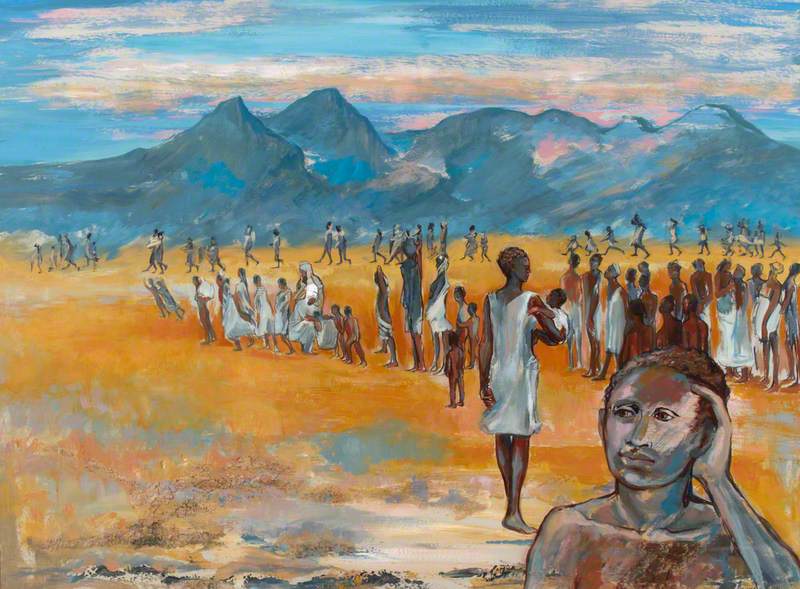
Is Famine Ever Permissible? Compulsory Migration Ethiopia 1991
Eve Goldsmith Coxeter (b.1928)
Part of the British Red Cross Museum collection, Eve Goldsmith Coxeter 's Is Famine Ever Permissible? Compulsory Migration Ethiopia (1991) illustrates the journey endured by Iraqi Kurds as a result of expulsion from the country during the Gulf War. The tragic circumstances laid bare — the rising streaks of heat in the unforgiving climate, as they endlessly march across the desert in search of a safe haven – suggest that the answer to the titular question may be obvious.
Yto Barrada
![journey painting artists Dormeurs [The Sleepers] Tangier, Fig. 2](https://d3d00swyhr67nd.cloudfront.net/w800h800/collection/BST/BMAGG/BST_BMAGG_K6306-001.jpg)
Dormeurs [The Sleepers] Tangier, Fig. 2 2006
Yto Barrada (b.1971)
In Yto Barrada 's photographic series Dormeur [The Sleepers] Tangier (2006), the perils of migration are exposed in the bustling setting of a city park. The sleepers have been photographed faceless and motionless, curled up in vulnerable positions as they await passage across the Strait of Gibraltar in search of better employment prospects in Europe.
These poses darkly mirror what could very well be their fate on the seas in the perilous journey. They reveal that in everyday, public spaces, lives may be in limbo, and that to live 'in the present' is a privilege and luxury that is not afforded to everyone.
John Watson Nicol

Lochaber No More 1883
John Watson Nicol (1856–1926)
The passengers in John Watson Nicol 's Lochaber No More (1883) are disconsolate and rueful, their contemplation stretching far beyond the seas they travel on. Their worldly possessions are assembled close to them on the ship's deck. As migrants make long and arduous journeys, they must travel light and pack items they deem most significant to them.
As the Highland Clearances drove a large number of people out of northern Scotland, the title 'Lochaber No More' refers to their forced separation from a place they have known forever. Like his father before him, Nicol was a vocal activist for Highland inhabitants and painted many of them in situations of plight.
Most recently, the Colombian-born artist Oscar Murillo used the work as a centrepiece for his installation at the 2019 Turner Contemporary in order to highlight how migration is not a practice that should be delegated to the 'other', or be seen as exotic.
Liam Belton
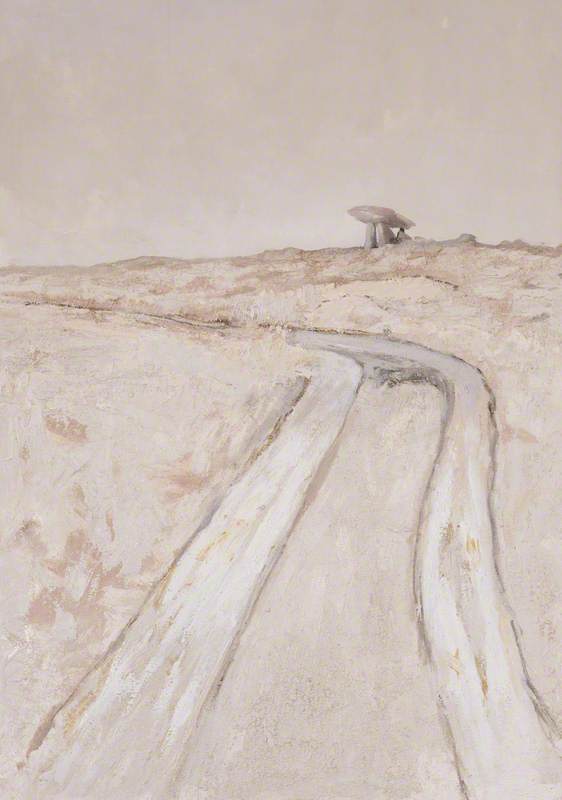
Kilclooney Dolmen, Donegal 2003
Liam Belton (b.1947)
Given the long history of migration in the North Atlantic Ocean, it comes as no surprise that the Art UK database is rich with works dedicated to the passage of people between Scotland and Ireland. Referencing the movement of people between the two countries during the Mesolithic and Neolithic eras, Liam Belton 's Kilclooney Dolmen, Donegal (2003) depicts a dolmen – or prehistoric tomb – atop a hill in Kilclooney, that is older than the pyramids of Giza. It reminds us that migration and the movement of people is not a recent phenomenon.
This work currently features in the Scottish Parliament, a testament to the political acknowledgement of migration's lasting impact on the country. A similar work by Margaret Leathart exists in the Northern Ireland Civil Service collection.
Mike McDonnell
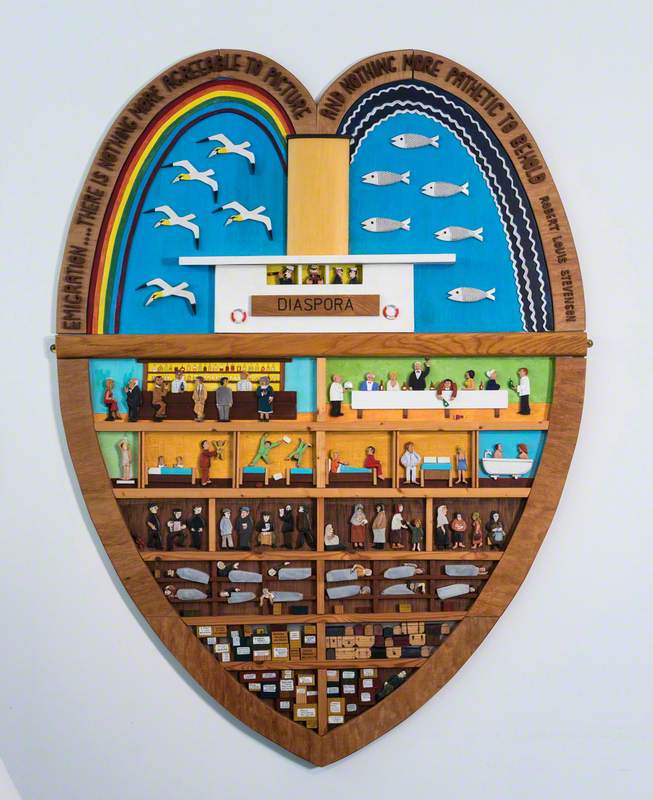
A Ship Named 'Diaspora' 2007
Mike McDonnell (b.1939)
In Mike McDonnell 's A Ship Named 'Diaspora' (2007), beneath a seemingly harmonious, or at least blissfully ignorant façade, the amiably cartoonish passengers reveal an uncomfortable reality. They journey together in the heart-shaped confines, but as the levels of the ship descend it becomes clear that passengers are divided based on privilege that reveals itself in race, religion, and class. McDonnell depicts a scathing commentary on how outwardly multicultural societies continue to insidiously practice segregation.
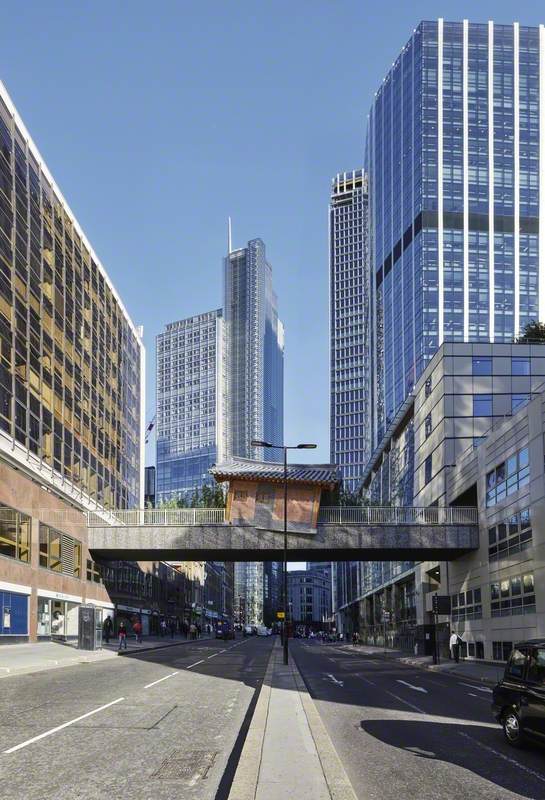
Bridging Home, London 2018
Do Ho Suh (b.1962)
Do Ho Suh 's Bridging Home, London (2018) illustrates the discordance a new inhabitant may feel in a place they still deem foreign, or where they are seen as such. On a busy street in Central London, a lopsided replica of Suh's traditional Korean childhood home sits incongruously with the skyscrapers towering over it, as if parachuted onto the path it sits on. Culture shock sets in as, unfamiliar with the values and mores of a new setting, some face a struggle to fit into a wildly different new society.

Woman in Grief 1968
Uzo Egonu (1931–1996)
Migration does not mean losing your sense of cultural identity. Far from that, it means fusing new identities together. Synthesising numerous motifs and experiences on a painted canvas is Uzo Egonu 's way of keeping the various facets of his multicultural identity intact.
In Woman in Grief (1968), Egonu uses the canvas to navigate the identity he has weaved between Nigeria and the United Kingdom. Conceived during the Nigerian Battles of Onitsha, the work was developed by Egonu as a means of personal connection with, and concern for his family in the war-torn region.

The Hand Made Map of the World 2013
Tam Joseph (b.1947)
What is thinking about migration without considering the borders that migrants have to pass through? Tam Joseph 's The Hand Made Map of the World (2013) reinterprets the navigational tool in an act of radical boundary-blurring and urges us to consider the harmful geopolitics of borders.
'People cross borders. / It's been that way ever since / borders crossed people,' writes Antoine Cassar in his 8 no-border haiku, and as we explore the new narratives that can emerge from Joseph's exercise of border-swapping, we realise that much of the histories of these perimeters are rooted in dispute and war.
These works mark different points in each individual's complex journey of separation, waiting, and longing. Whether depicting a scene of tragedy or as an expression of personal anguish, beneath the exterior of migration-themed art often lies an urgent call to action. These works resonate with this moment of crisis, and urge us to act.
Ashley Tan, freelance writer
- Share on Facebook
- Share on Twitter
More stories

Learning resources
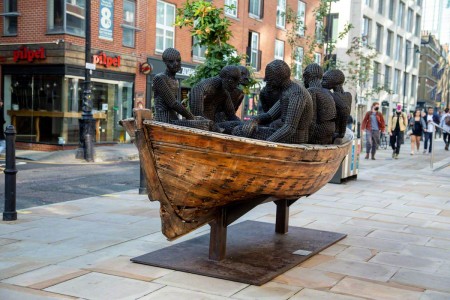
- Foundation Reports
- Our Offices
- Grants and Fellowships
- Grants Database
- Fellows Database
- Grantee Resources
- Art Collection
- Image Rights and Reproductions
- Library for American Art
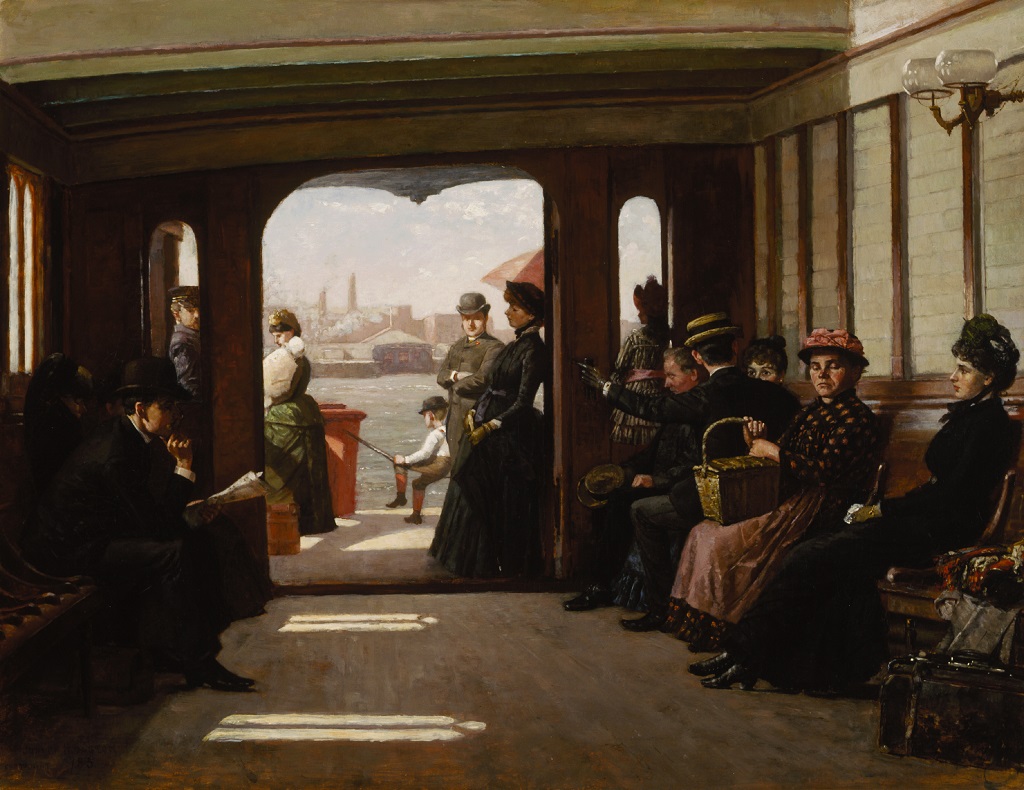
Joseph H. Boston (1860-1954) From Shore to Shore , 1885 Oil on canvas Image: 27 5/8 x 35 5/8 in. (70.2 x 90.5 cm) Frame: 37 1/16 x 45 3/16 in. (94.1 x 114.8 cm) Terra Foundation for American Art, Daniel J. Terra Collection, 1999.13
Journeys: Exploring Inner Journeys in Art and Text
Sara Jatcko, Terra Foundation for American Art Manuel Valderrama, Lane Tech College Prep High School
By conducting close readings of works of visual art and poetry, students will explore how artists connect physical journeys with inner journeys of human experience. Students will also write narratives that depict real and imagined journeys.
Lesson Overview
Grade Levels: 9–12
Time Needed: 4–5 class periods, 40–50 minutes each
Background Needed
No specific background is needed for this lesson.
Essential Questions
- What is a journey?
- How can a work of art or literature take you on a journey?
- How can a physical journey inspire a journey of the imagination?
Enduring Understandings
- Artists and writers can create works that explore inner journeys of human experience as well as external, physical journeys.
- A close reading of a work of art or literature can lead us on an inner journey.
- Students will determine central ideas or themes of a text and analyze their development.
- Students will integrate and evaluate content presented in diverse media and formats, including visually as well as in words.
- Students will write narratives to develop real or imagined experiences and events using effective technique, well-chosen details and well-structured event sequences.
- Students will prepare for and participate effectively in a range of conversations and collaborations with diverse partners, building on others’ ideas and expressing their own clearly and persuasively.
Key Vocabulary
- inner journey
- perspective
Standards Connections
Common Core State Standards
Anchor Standards in Reading:
http://www.corestandards.org/ELA-Literacy/CCRA/R/
- CCSS-ELA Reading Anchor Standard 2: CCSS.ELA-LITERACY.CCRA.R.2
- CCSS-ELA Reading Anchor Standard 7: ELA-LITERACY.CCRA.R.7
Anchor Standards in Writing:
http://www.corestandards.org/ELA-Literacy/CCRA/W/
- CCSS-ELA Writing Anchor Standard 3: CCSS.ELA-LITERACY.CCRA.W.3
Anchor Standards in Speaking and Listening:
http://www.corestandards.org/ELA-Literacy/CCRA/SL/
- CCSS-ELA Speaking and Listening Anchor Standard 1: CCSS.ELA-LITERACY.CCRA.SL.1
In the Classroom
- a computer with Internet access
- an interactive whiteboard or another classroom projector
Works of Art
- Joseph H. Boston, From Shore to Shore
Other Resources
- Art Study: From Shore to Shore , Read to Build Understanding
- Walt Whitman, “Crossing Brooklyn Ferry”
- Close Reading Guide: “Crossing Brooklyn Ferry”
Lesson Steps
- Have students document an everyday journey: Ask students to jot down or draw* what they see, hear, or experience while traveling to or from school. Ask students if the journey’s endpoint affects the details they remember. Why were they drawn to these specific details of their journey? What might others traveling with them have noticed? Consider discussing how an individual’s perspective, life context, and destination affect what he/she notices.
*Note: While using cell phones to film the experience could be useful, it could be seen as intrusive by othergs and may not be safe.
- Guide a close reading of a work of art: Project Joseph Boston’s painting From Shore to Shore and ask students to record the details they notice about the painting. Use the questions and prompts below as a starting point, but encourage students to address details from the painting that interest them or provoke questions.
- Spend a few minutes looking closely at this work of art. Write down five things you notice. What did you notice and why?
- Describe the people portrayed in this painting. What do their clothing and belongings tell you about who they might be and when this painting might have been made?
- What do the different people appear to be doing?
- Which people do you notice the most? What makes you notice them?
- Notice the way the artist uses color and value contrasts to separate different spaces within this scene. Describe these different spaces.
- What kind of place is shown here? Provide evidence for your response.
- Based on the artist’s use of light and shadow, at what time of day do you think this scene is taking place?
- What’s your (the viewer’s) vantage point on this scene? How does the arrangement of the composition invite or allow you to enter the scene?
- What do you think is the subject or main idea of this painting?
- What attitude about the subject matter do you think the artist is conveying? Which details make you think this?
- Have students read an informational text about the painting: Distribute copies of the Art Study: From Shore to Shore , Read to Build Understanding. Have students work with partners to read the text and annotate or highlight the passages that give them new insights about the painting and its meaning. Then lead a whole-class discussion with questions like the following:
- How do your initial observations about Boston’s painting compare with the information presented in the text?
- Does the informational text change the way you experience and/or make sense of the painting?
- As you look at the painting now, do you see details that suggest a deeper meaning, beyond an everyday journey?
- Does it affect your confidence in your initial observations?
- Have students write a narrative based on the painting: Tell students to choose one of the people depicted in From Shore to Shore. Students should write either a diary entry or a letter from the perspective of the person they chose that explains where the person is going and why he or she is making this journey. Encourage them to incorporate details from the painting and the informational text to make the narrative more vivid and realistic.
- Guide a close reading of the poem that inspired Boston’s painting: Remind the class that the painting From Shore to Shore by Joseph Boston was inspired by Walt Whitman’s poem, “Crossing Brooklyn Ferry.” Project or distribute copies of the poem. Because of its length, you may wish to focus on the first three stanzas or identify another excerpt from the poem to examine closely.
Before reading the poem with students, explain that Walt Whitman was born in Long Island, NY, in 1819 and grew up in Brooklyn. At the time he wrote this poem, there were no bridges connecting Brooklyn and Manhattan, so people had to cross by ferry or another type of boat. Whitman is frequently referred to as “America’s poet,” as he often celebrated the sights and sounds of America and its founding principles within his poetry. (For a timeline of Whitman’s life, see the following: http://www.pbs.org/wgbh/amex/whitman/timeline/ .)
Read aloud the selected excerpt from the poem to the entire class. As they listen, students should consider the following questions:
- Who is narrating the poem?
- What experience does the narrator seem to be sharing?
Divide the class into small groups and distribute copies of the Close Reading Guide: “Crossing Brooklyn Ferry” to each student. Tell students to have one person in the group read the poem excerpt aloud a second time. The other students should note unfamiliar vocabulary words in the box on the Close Reading Guide. Students should work together to determine the meanings of these words, consulting dictionaries and online resources as needed.
Have the groups read the poem again, either aloud or silently. After this reading, students should discuss the questions on the Close Reading Guide with their group members. Each member of the group should record responses to these questions.
- What is the setting of this poem? How do you know?
- Who is speaking? What, if anything, can you infer about the speaker, such as age, gender, social class, etc.?
- Who is the speaker speaking to?
- How is this poem organized?
- Walt Whitman frequently included lists in his poems. What lists do you find in this poem? What effect do these lists have on the poem?
- How do rhythm and repetition contribute to the poem? In what ways does the rhythm of the poem reflect the subject and setting of the poem?
- Guide a class discussion on the poem: Invite students to share their responses to the previous questions with the class. Then deepen the discussion with questions such as the following:
- In the first stanza, what kinds of crossings could the speaker be referring to?
- What is the speaker’s relationship to the other passengers on the ferry? Which words and phrases reveal this relationship?
- How does the speaker’s perception of this relationship change during the course of the poem?
- In this poem, Whitman reflects on both physical and inner journeys. What physical journeys does Whitman address? What kinds of inner journeys does he address? Cite specific passages that illustrate these two types of journeys.
- “Tone” is the speaker’s attitude toward the subject expressed through word choice. What is the dominant tone of the poem in this excerpt? What words and phrases in the poem support your answer?
- What is the theme of this poem? In other words, what message is the poet conveying through this poem? Provide evidence from the text for your response.
- Have students compare and contrast the poem and the painting: Guide the discussion with questions like the following:
- Do you think that Boston’s painting, From Shore to Shore, and Whitman’s poem, “Crossing Brooklyn Ferry,” present similar or different ideas about the Brooklyn Ferry and the journey of life? Cite evidence from the painting and poem in your answer.
- How do these two works show the same type of journey in different ways?
- How does the painting affect you as a viewer? How does the poem affect you as a reader or a listener? In what way does the medium affect the message each artist is communicating?
- Are there any details of this journey that the painting conveys more vividly than its source poem?
- What does the poem say that the painting cannot show?
- Have students re-chronicle a mundane or everyday journey: Revisit the writing exercise from step. Tell students to chronicle the journey from home to school again, creating a narrative in written or visual form or both. In either medium, students should carefully think about how they will use form, content, craft, and structure to convey the meaning of the journey. To guide students’ work, ask them to consider the following:
- Think back to the text and work of art we’ve examined: Joseph H. Boston’s From Shore to Shore and Walt Whitman’s “Crossing Brooklyn Ferry.” What techniques did each author/artist use? Which techniques resonate with what you want to convey about your own journey? What parts of the journey will you represent? What details will you include?
- What message do you want to convey?
- What techniques can you use to express the mood, tone, and meaning of your journey?
- Discuss students’ narratives: Have students present their narratives to the class. After their presentations, lead a discussion using the following questions:
- Did knowledge of the destination affect what you noticed during or about the journey? How did the exercise of noticing and recording your journey affect the way you think about your destination once you arrived? To what extent did your awareness of the task of rendering or describing the journey affect what you noticed during the journey?
- Why did you choose to chronicle your journey through art/writing/ a combination of the two?
Extension Activities
Write a Comparison
Have students write an essay to compare how Boston and Whitman establish a connection between physical journeys and inner journeys in their respective works, From Shore to Shore and “Crossing Brooklyn Ferry.” Students should point out the techniques that each uses to express this connection, citing examples.
Additional Resources
Poetry Foundation. “Walt Whitman: Biography.” Accessed December 15, 2014. http://www.poetryfoundation.org/bio/walt-whitman
Public Broadcasting Service. “Walt Whitman: Timeline.” Accessed December 15, 2014. http://www.pbs.org/wgbh/amex/whitman/timeline/
The Walt Whitman Archive. “Life and Letters.” Accessed December 15, 2014. http://www.whitmanarchive.org/biography/index.html
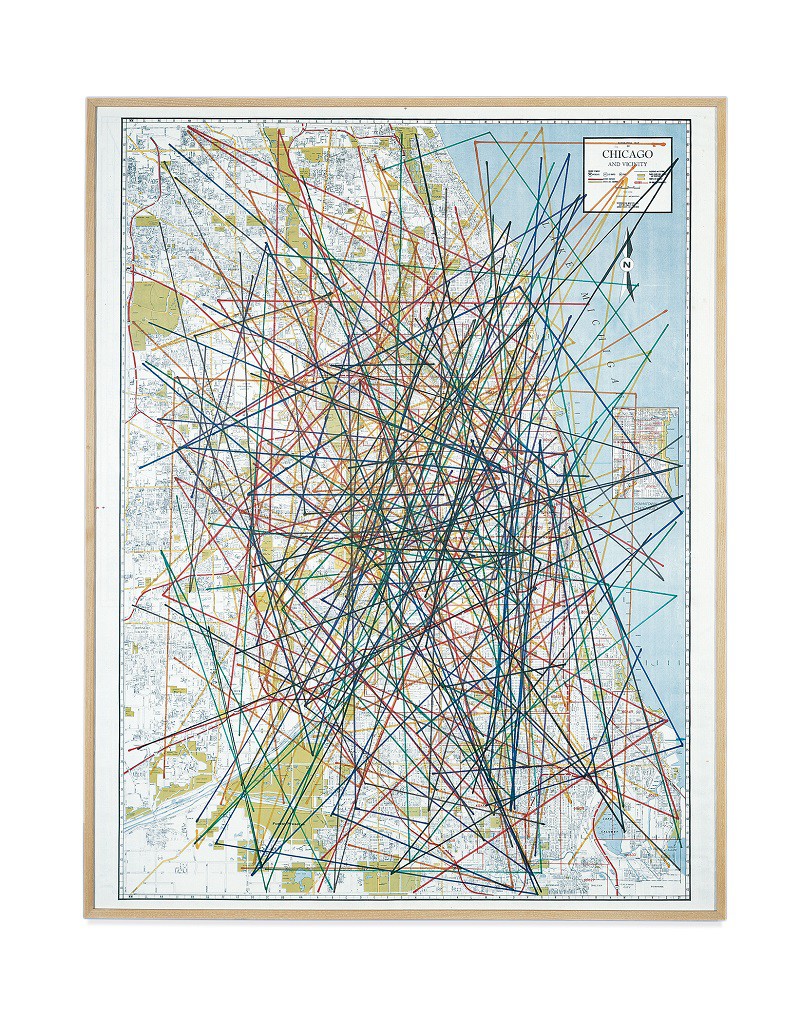
- Privacy Overview
- Strictly Necessary Cookies
- 3rd Party Cookies
This website uses cookies so that we can provide you with the best user experience possible. Cookie information is stored in your browser and performs functions such as recognising you when you return to our website and helping our team to understand which sections of the website you find most interesting and useful.
Strictly Necessary Cookie should be enabled at all times so that we can save your preferences for cookie settings.
If you disable this cookie, we will not be able to save your preferences. This means that every time you visit this website you will need to enable or disable cookies again.
This website uses Google Analytics to collect anonymous information such as the number of visitors to the site, and the most popular pages.
Keeping this cookie enabled helps us to improve our website.
Please enable Strictly Necessary Cookies first so that we can save your preferences!
Skip to Content

Online Gallery

Max Cole: Endless Journey
“art is something that has to be lived. it is long and there are no shortcuts.” -max cole.
SITE Santa Fe is pleased to present Endless Journey , a solo exhibition by New Mexico-based artist, Max Cole.
Featuring a selection of paintings and works on paper spanning 1962-2022, Endless Journey surveys over six decades of Cole’s ongoing career including many never-before-seen works. Cole’s iconic paintings invite viewers on a meditative journey through her lifelong investigation of rhythmic repetitive line and composition. The exhibition features over 30 works, including significant loans from the Tia Collection, Santa Fe and the Museum of Contemporary Art, Los Angeles.
Written like music or poetry, Cole’s lines are records of movement, keepers of time. The slight variation in each hand-made mark creates a visual echo that vibrates across the canvas creating a visceral and immersive experience for the viewer.
- &source=https://sitesantafe.org','MyWindow','width=600,height=400'); return false;" title="Share on LinkedIn" target="_blank" class="icon-linkedin">

About the Artist

Cole has received honors and fellowships from the University of Arizona, the National Endowment for the Arts, the Pollack/Krasner Foundation, the Adolph Gottlieb Foundation, The Roswell Museum and Art Center, and The Joseph and Anni Albers Foundation. In 1988, she received a grant from the State Department for an exhibition at the National Gallery of Fine Art in New Delhi, India, and she attended a Contemporary Artist’s Meeting with the Pope at the Sistine Chapel in 2009.
Cole’s career commenced in 1976 with a four-person exhibition entitled New Abstract Painting at the Los Angeles County Museum of Art. Between 1979 and 1984, her work was featured in four exhibitions at the Sidney Janis Gallery in New York City. She was a part of two exhibitions at Albright Knox, one in 1979 and the next in 2007. In 2004, she held a solo exhibition at the Kolumba Museum in Cologne, Germany. Her work was permanently installed in Italy’s Panza Collection in 2000, and it was included in The Splendor of Truth, the Beauty of Charity in the Vatican in 2011. She had a solo exhibition in 2012 at the Mies van der Rohe Haus in Berlin entitled To the Line . In 2013, her solo exhibition, Meditations , was held at St. Peter’s Cathedral in Cologne. Her work was also featured in Guiseppe Panza di Biumo: American Dialogs, Ca’ Pesare in 2015, for which the International Gallery of Contemporary Art in Venice collaborated with The Museum of Contemporary Art in Los Angeles, The Guggenheim in New York, and the Panza Collection in Italy. Cole’s paintings were most recently acquired by the Tia Collection in Santa Fe, New Mexico. She has exhibited work in numerous other museums in Europe and the United States, and her work continues in an endless journey.
Accompanying Programs

SITE Santa Fe opens to new solo exhibitions, Shirin Neshat: Land of Dreams and Max Cole: Endless Journey with food, drinks, and music!
Join us for a My Life in Art talk between exhibiting artist Max Cole and art historian David Pagel, who penned Cole’s favorite review of her work. This special event will be the first in-person meeting between Cole and Pagel.
Related Events
- Oct 9, 2022 My Life in Art
- Oct 7, 2022 Two Openings One Night
Related Press
- Looking Between the Lines of Max Cole’s Abstract Paintings by Amy Ellingson Hyperallergic January 2, 2023
- Going deep enough: Max Cole by Phillip Lutz The Santa Fe New Mexican Pasatiempo December 30, 2022
- Max Cole Endless Journey Image Sheet October 19, 2022
- Max Cole Endless Journey Press Release October 17, 2022
- Fall/winter arts season preview: Visual Arts by Michael Abatemarco The Santa Fe New Mexican Pasatiempo September 16, 2022
Support for Endless Journey is generously provided by
Site santa fe board of directors, site santa fe annual exhibition fund, art santa fe presents, inc., mary cardas and les edelberg, dalia and michael engler, jayne and michael flinn, charlotte jackson fine art, henry r. muñoz iii, christophe a olson - roebling endowment & josed granados, melba and ted whatley.

The journey of local artist Reggie Gopaul at Art in the Park
Gopaul's association with art in the park dates back to its earlier days at alexandra park..
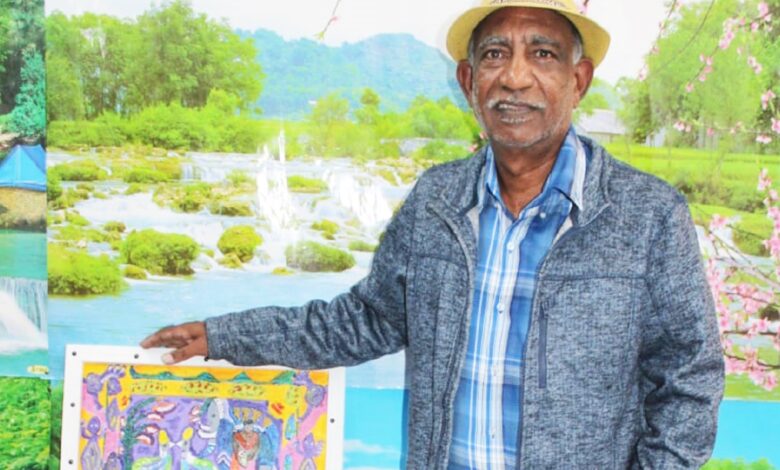
Reggie Gopaul, a familiar face at Art in the Park, is gearing up for his landmark tenth exhibition at the renowned Art in the Park.
Gopaul’s journey through art is nothing short of extraordinary, marked by resilience and the triumph of the human spirit.
Gopaul’s association with Art in the Park dates back to its earlier days at Alexandra Park.
Despite not being a natural-born artist, his story took an unexpected turn when he was afflicted with dystonia, a condition that rendered his right hand virtually immobile.
ALSO READ | Bumper event promised for 60th Art in the Park festival
For Gopaul, this meant grappling with the inability to perform everyday tasks. However, fate had something remarkable in store. In a twist of fate, Gopaul discovered that he could lift a paintbrush with his affected hand.
It was a moment of sheer serendipity that opened the door to a newfound ability.
Against the odds, Gopaul found solace and expression through painting, harnessing his unique circumstance to create beauty on canvas.
Since that pivotal moment, Gopaul has defied limitations, producing over 400 artworks by his hand — a testament to the power of determination and creativity.
His journey serves as an inspiration, particularly to young aspiring artists, demonstrating that adversity can be transformed into opportunity with the right mind-set.
ALSO READ | Art in the Park: Celebrating art ‘Through the Eye of a Child’ competition
As Art in the Park prepares for its upcoming edition at the Pietermaritzburg Botanical Gardens, from May 1 to May 5, 2024, Gopaul stands ready to showcase his latest creations.
Visitors can expect to be captivated by his distinctive style and the profound story behind each stroke of his brush.
For those seeking more information about the event, inquiries can be directed to Mpume Ngubane at [email protected] or by calling 0333451348/9.
Reggie Gopaul’s journey is a reminder that art knows no bounds, and true creativity can flourish even in the face of adversity.
Opinion | Purely a business decision
Visvin reddy in the dock for allegedly inciting public violence, related articles.

WATCH | IFP holds KZN Provincial manifesto rally in Ulundi

Six men kidnapped in Pietermaritzburg rescued in Durban

Slain Pietermaritzburg doctor laid to rest

School’s Thukela River conquest
- global">Global
- indonesia">Indonesia
- united_kingdom">United Kingdom
ニュースレターに登録して、“最新情報“を見逃さないようにしよう。
購読ボタンをクリックすることにより本サイトの 利用規約 と プライバシーポリシー に同意するものとします。
アプリをダウンロードする
- dark_mode" data-event-name="menu_navigation" data-custom-event="null" class="dark-mode icon-type d-none d-lg-flex nav-item">
- アカウントの作成">アカウントの作成
- search" data-event-name="menu_navigation" data-custom-event="null">
SWATCH ART JOURNEY 2024で巨匠のアートを腕元に
過去にmomaやジャン=ミシェル・バスキアとコラボしてきたswatch art journeyの2024年は、英国・ロンドンのtate galleryと連携したアートなウォッチコレクション.

SWATCH ART JOURNEY 2024
そのグラフィックやアートワークがカッコ良くて、“ツラ”で選んだロックTシャツ。その後、そのミュージシャンの曲を知って、その音楽性を好きになったりすることはないだろうか? この「 SWATCH ART JOURNEY 2024 (スウォッチ アート ジャーニー 2024)」と名付けられたコレクションは、それと同じような可能性を秘めている。
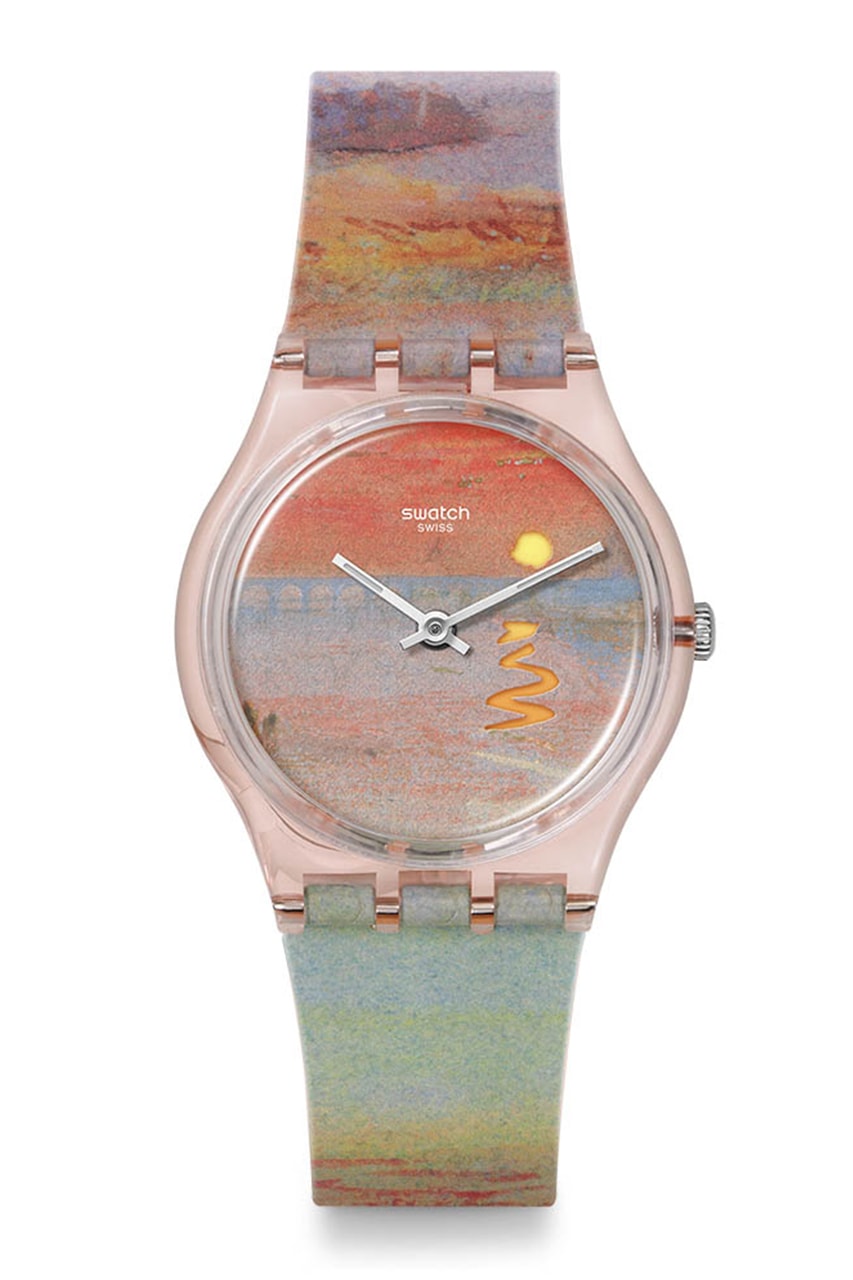
●問い合わせ:SWATCH JAPAN https://www.swatch.com/ja-jp/ Tel:0570-004-007
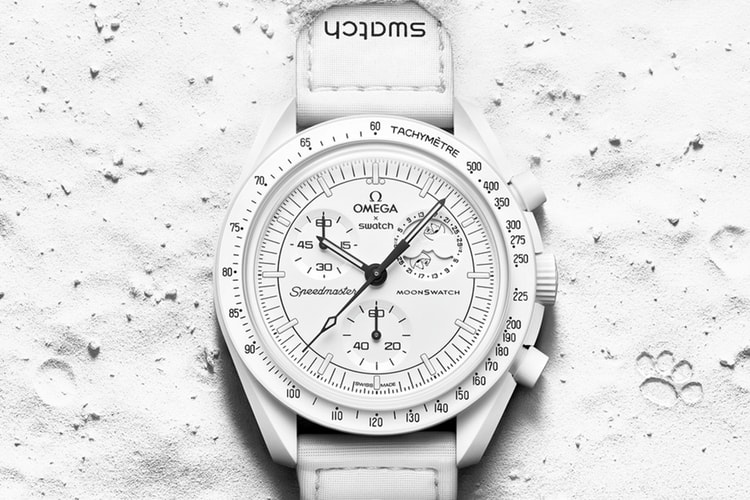
OMEGA x swatch ムーンスウォッチにスヌーピーをフィーチャーした新作が登場
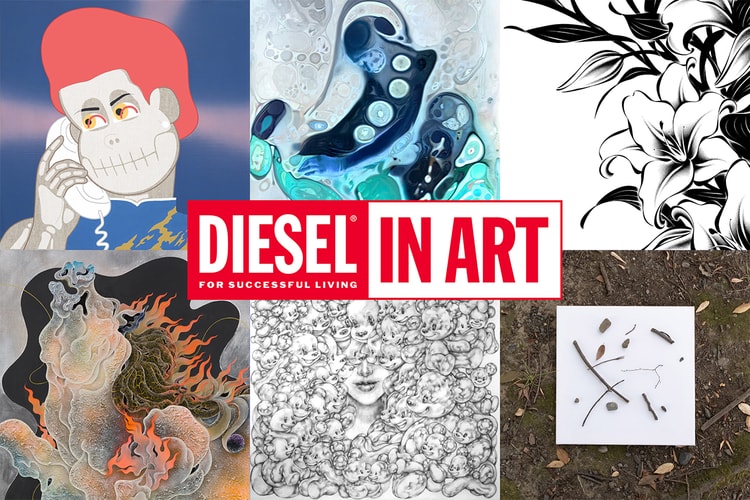
DIESEL がアートとファッションを融合したポップアップストア “DIESEL IN ART” を阪急うめだ本店にて開催
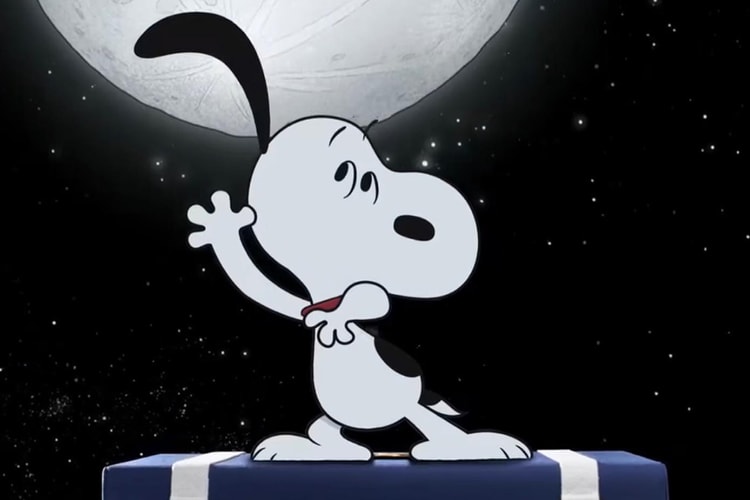
OMEGA x swatch ムーンスウォッチにスヌーピーとのコラボモデルが登場?
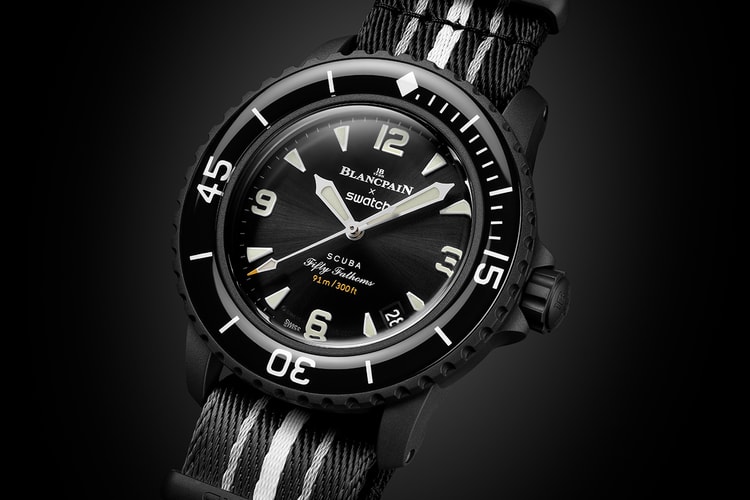
Blancpain x Swatch から“月の海”をイメージした新作ウォッチ OCEAN OF STORMS が登場
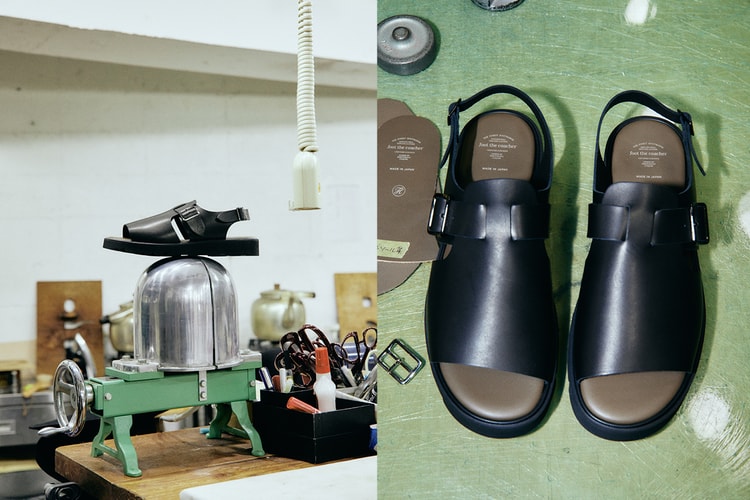
KIJIMA TAKAYUKI から foot the coacher / BEAUTIFUL SHOES とのコラボサンダルが登場
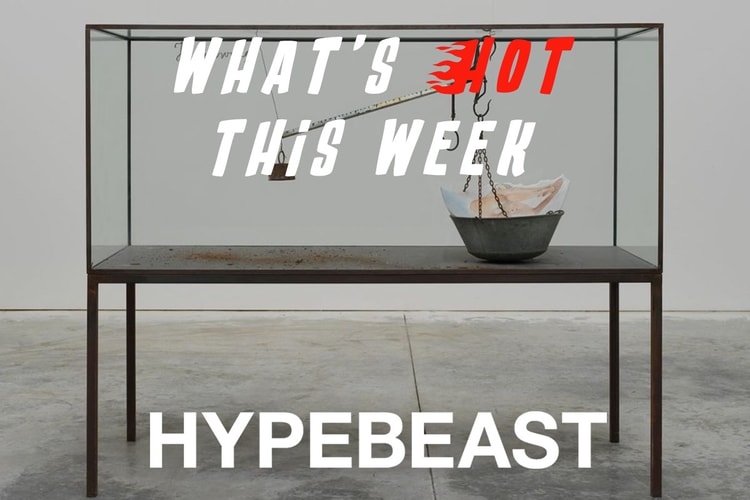
今週の“行かなきゃ損する”イベントガイド | What's Hot?!
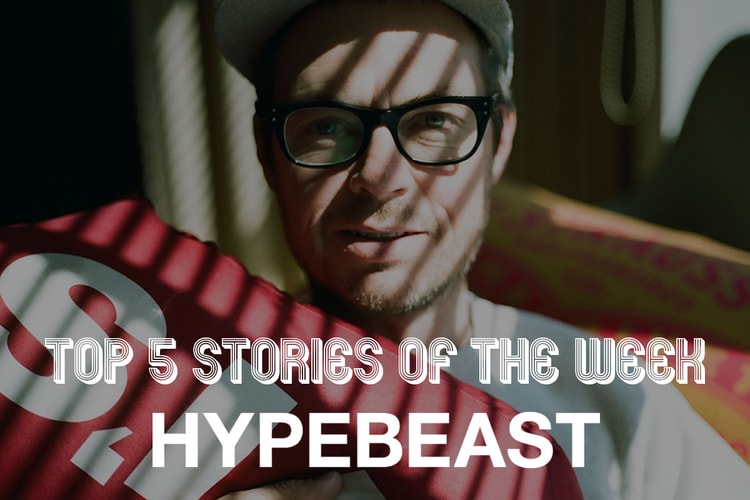
押さえておきたい今週の必読記事5選
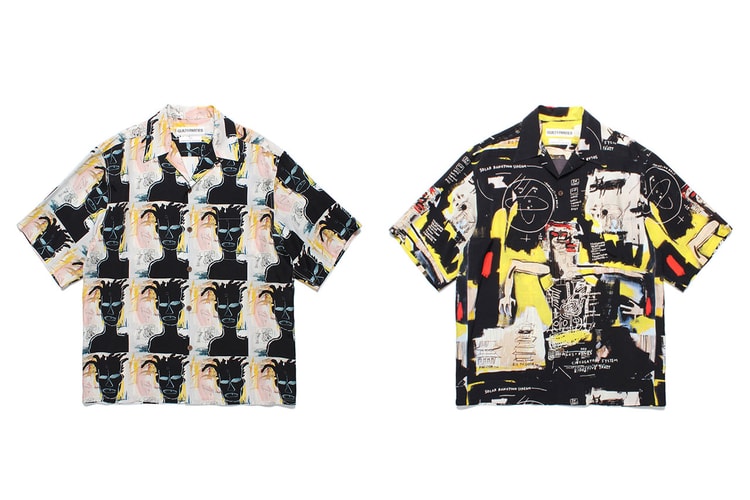
WACKO MARIA x ジャン=ミシェル・バスキアの最新コラボアイテムが発売
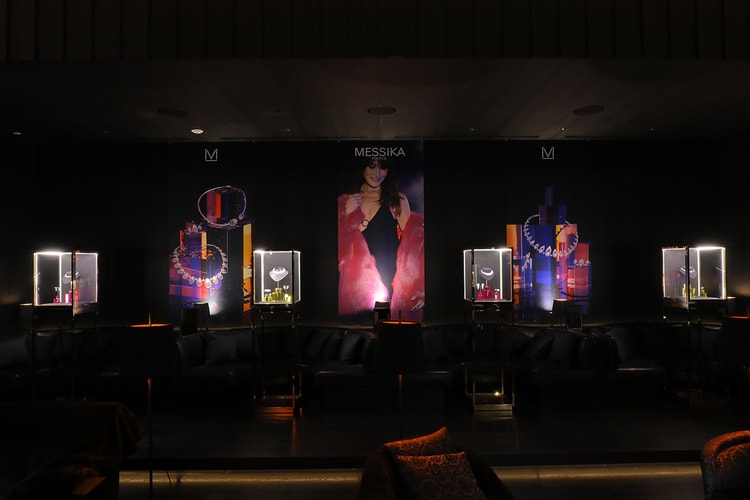
1970年代のナイトシーンに着想した MESSIKA の新作コレクション展示パーティに潜入

今秋 Apple から廉価版 AirPods が登場との噂
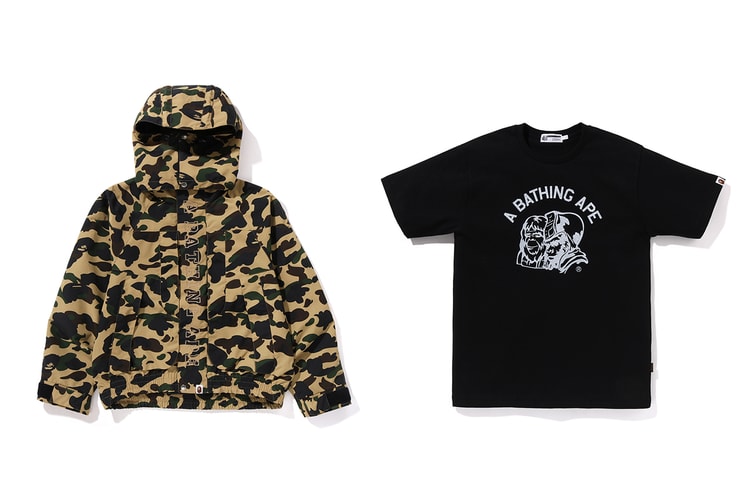
A BATHING APE®︎ が過去のアーカイブアイテムを復刻

オリジナルを忠実に再現した Air Jordan 11 “Columbia”の公式ビジュアルをチェック
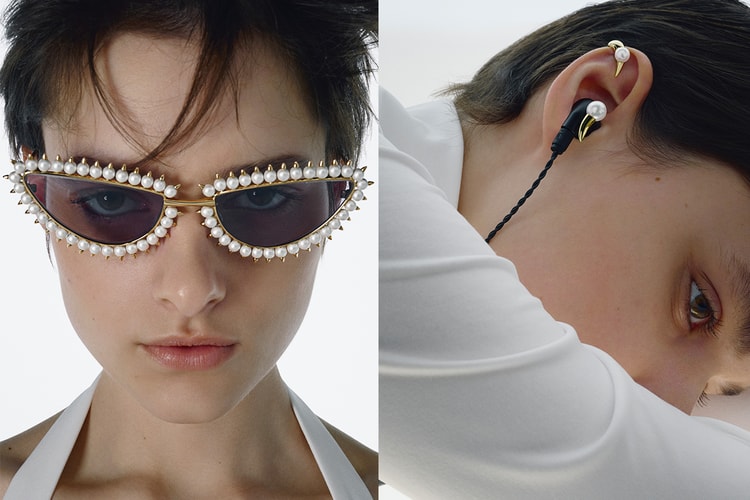
TASAKI が創業70周年を記念してラグジュアリーなアイウェアとイヤホンを発表

ビリー・アイリッシュが Instagram の“親しい友だち”で最新アルバムを予告?
Hypebeastについて.
- WEATHER ALERT Flood Warning Full Story
Through Their Eyes: New exhibit showcases artistic journey of those with autism

HOUSTON, Texas -- Art is a wonderful form of expression, it can also be a form of life changing therapy. The students at Monarch School and Institute are using their skills and talents to learn and live.
The Head of the school, Patti Pace sees art help students with neurological differences including autism everyday, "A lot of individuals who struggle with communication, like talking with one another, can express themselves through art."
Student Madison loves to express herself through her abstracts, "It's really good to get all of my emotions out, that's what I do here, it's really therapeutic."
As part of Autism Awareness Month, The Museum of Fine Arts-Houston's Glassell School of Art has invited the students to display and show off their artistic talents.
Madison says with a smile, :"t's really cool I didn't expect it to be such a big deal."
Paul Coffey, The director of Glassell School of Art is proud to show off the students work, "Artists are always looking for different ways of seeing, these students come and teach us. We have been doing this this all of our lives and we still learn from them."
The exhibit runs from April 5 - May 3, 2024.
Related Topics
- MUSEUM EXHIBIT
Top Stories

Iowa takes on South Carolina in women's national championship game

Chicago Weather: Showers, windy Sunday

Final countdown begins for total solar eclipse gatherings in Illinois

Cubs debut sensory room at Wrigley Field

Israeli military says it has withdrawn its forces from Khan Younis
- 41 minutes ago
Houston-bound flight lands back in Denver after engine cover flies off
Winning $1.3 billion Powerball ticket sold in Oregon
Our Chicago: Total solar eclipse travel tips
Migrant's journey captured through art at Starting Point Community Church exhibit
Migrant in chicago shares journey through art.
Migrants have been given a starting point at Starting Point Community Church. Now through art, one man is sharing his experience of getting here.
CHICAGO - It’s all in the name at Starting Point Community Church in the city’s Belmont Cragin neighborhood, where migrants have been given a ‘starting point’ in Chicago.
This weekend, one man is sharing his experience of journeying to the United States – through art.
"Their stories are phenomenal and impactful, and they have life experiences that I will never have," said Pastor Jonathan de la O, with SPCC.
It's a journey most of us could never imagine but through brushstrokes of passion and emotion, Yeison Perez is helping others understand.
Last spring, the church began to house a small group of migrants – up to 20 people at a time. There, they can find their footing, apply for asylum, seek work opportunities, and eventually locate permanent housing.
Currently, 18 individuals – including Perez – are calling the church ‘home.’
The 31-year-old ventured to America from Venezuela last July, enduring a treacherous journey, including a trek through the Darién Gap.
"They put us on little boats in the middle of the night and it’s open sea for two hours, and I’ve never been more afraid in my life," said Perez.
For Perez, his love of art began when he was a young boy, and picking up a paintbrush came naturally.
"My dad was an artist, and so I inherited from him, and I found out through my dad that my great-grandfather was also an artist," said Perez.
When he opened his doors, Pastor de la O wanted people to understand the ‘why.’
"I thought art would be appealing," said de la O.
Perez got to work and spent two months painting eight pieces for the exhibit.
"He came such a long way," said de la O.
His paintings are up for silent auction and much of the money earned will be sent to his family in Venezuela.
"There’s a lot of these guys that have amazing talents and gifts and we just need to give them a chance," said de la O.
For one more day, you can tour Perez’s exhibit and bid on his artwork.
The show will be open Saturday, April 6th from 11 a.m. until 3 p.m. at Starting Point Community Church, located at 4851 West Wrightwood Avenue.
To learn more about Starting Point Community Church and how you can give back to its mission of housing migrants, follow this link .
- Share full article
For more audio journalism and storytelling, download New York Times Audio , a new iOS app available for news subscribers.

- April 7, 2024 The Sunday Read: ‘What Deathbed Visions Teach Us About Living’
- April 5, 2024 • 29:11 An Engineering Experiment to Cool the Earth
- April 4, 2024 • 32:37 Israel’s Deadly Airstrike on the World Central Kitchen
- April 3, 2024 • 27:42 The Accidental Tax Cutter in Chief
- April 2, 2024 • 29:32 Kids Are Missing School at an Alarming Rate
- April 1, 2024 • 36:14 Ronna McDaniel, TV News and the Trump Problem
- March 29, 2024 • 48:42 Hamas Took Her, and Still Has Her Husband
- March 28, 2024 • 33:40 The Newest Tech Start-Up Billionaire? Donald Trump.
- March 27, 2024 • 28:06 Democrats’ Plan to Save the Republican House Speaker
- March 26, 2024 • 29:13 The United States vs. the iPhone
- March 25, 2024 • 25:59 A Terrorist Attack in Russia
- March 24, 2024 • 21:39 The Sunday Read: ‘My Goldendoodle Spent a Week at Some Luxury Dog ‘Hotels.’ I Tagged Along.’
The Sunday Read: ‘What Deathbed Visions Teach Us About Living’
Researchers are documenting a phenomenon that seems to help the dying, as well as those they leave behind..
By Phoebe Zerwick
Read by Samantha Desz
Produced by Jack D’Isidoro and Aaron Esposito
Narration produced by Anna Diamond and Emma Kehlbeck
Original music by Aaron Esposito
Engineered by Sophia Lanman and Sharon Kearney
Listen and follow The Daily Apple Podcasts | Spotify
Chris Kerr was 12 when he first observed a deathbed vision. His memory of that summer in 1974 is blurred, but not the sense of mystery he felt at the bedside of his dying father. Throughout Kerr’s childhood in Toronto, his father, a surgeon, was too busy to spend much time with his son, except for an annual fishing trip they took, just the two of them, to the Canadian wilderness. Gaunt and weakened by cancer at 42, his father reached for the buttons on Kerr’s shirt, fiddled with them and said something about getting ready to catch the plane to their cabin in the woods. “I knew intuitively, I knew wherever he was, must be a good place because we were going fishing,” Kerr told me.
Kerr now calls what he witnessed an end-of-life vision. His father wasn’t delusional, he believes. His mind was taking him to a time and place where he and his son could be together, in the wilds of northern Canada.
Kerr followed his father into medicine, and in the last 10 years he has hired a permanent research team that expanded studies on deathbed visions to include interviews with patients receiving hospice care at home and with their families, deepening researchers’ understanding of the variety and profundity of these visions.
There are a lot of ways to listen to ‘The Daily.’ Here’s how.
We want to hear from you. Tune in, and tell us what you think. Email us at [email protected] . Follow Michael Barbaro on X: @mikiebarb . And if you’re interested in advertising with The Daily, write to us at [email protected] .
Additional production for The Sunday Read was contributed by Isabella Anderson, Anna Diamond, Sarah Diamond, Elena Hecht, Emma Kehlbeck, Tanya Pérez and Krish Seenivasan.
Advertisement
How to selectively modify a Midjourney image to create an artistic statement

This is where we're going to end up, blending my creative ideas with generative capabilities provided by Midjourney and Photoshop.
At the beginning of 2023, we were wowed by AI turning text into a representative image. As the year progressed and we started to use tools like Midjourney , DALL-E 3 , and Adobe Photoshop Generative Fill more, we needed to do even more.
Users clamored for the ability to selectively modify part of an image. It was nice that Midjourney (and I'm mostly focusing on Midjourney in this article) could create an image. But it would be nicer if we could get the AI to make some changes to the generated image for a more custom feel.
Also: The best AI image generators to try right now
In the AI image creation world, this capability is often called "inpainting." Midjourney added inpainting capabilities in August 2023, calling it "Vary (Region)."
In this article, I'm going to show you how you can use inpainting to create a custom piece of art.
I have always loved the 1942 painting Nighthawks by Edward Hopper. In a lot of ways, it reflects my life before I got married. I'm a night person and I spent many a late night in diners and Denny's doing homework or writing. I grew to love the empty quiet and the eclectic folks I met during the wee hours of the night.
Nighthawks is a painting of a nearly-deserted all-night diner, with a few customers and a server. The Art Institute of Chicago quoted Hopper as saying, "unconsciously, probably, I was painting the loneliness of a large city."
I decided I wanted to create an image that reflected the spirit of Nighthawks, but use inpainting to make some additions that would act as commentary about our modern era.
Generating the starter image
The first step in my quest to reimagine Nighthawks for the 21st century was to create a starter image. For this, I needed a text prompt. I wanted to describe the style, but I didn't want to mention the actual painting, because I wanted Midjourney to generate a new take on it. Here's the prompt I used:
Exterior view of a downtown diner late at night, with a few people inside. Mood of isolation and urban solitude. The diner's large glass windows illuminate a dark, deserted street, enhancing the sense of quiet and introspection. Done in the style of Edward Hopper.
I got back the following set of four images:
I liked the first image, and chose to upscale it. Upscaling is done by clicking one of the U buttons as shown:
This is the starter image I chose to work with:
Enter the Easter Bunny
Bear with me for a moment. We're creating art here. My vision will become apparent over time. It'll be worth it, I promise.
From the beginning of this project, I knew the work needed to include something about smartphones. Initially, I thought I'd do something like put a newsstand outside and have someone with a smartphone, but I just couldn't convince Midjourney to generate a newsstand.
Then I had the aha moment that changed everything for this piece. My wife was out celebrating Easter while I was working on this project. And I thought, "What if I added a giant Easter Bunny?"
I had just showcased Liam Neeson playing the Easter Bunny in my weekly newsletter , and so I must have had giant bunnies on my mind.
Where does inspiration come from? Everywhere.
To do some inpainting in Midjourney, start with the upscaled image you want to use, and click Vary (Region):
You'll be presented with an editing window. There are two tasks you need to do here. First, draw a rectangle or freehand selection around the area where you want to make your modification (shown at 1) and then create a prompt for what you want generated (shown at 2):
I got back four bunny images:
I chose the fourth image:
Unlike the other three, this bunny was looking into the diner. I thought it was perfect. Here was a giant bunny, staring wistfully into the diner. The Easter Bunny is often a symbol of spring and rebirth, and here was a bunny in the cold of night, just wishing it could go inside, into the warmth.
Notice also how it perfectly matches the painting style of the rest of the image, and how it's placed and sized based on my selection rectangle.
Smartphone myopia
Now, it was time for the smartphone. Once I saw how the bunny turned out, I knew what I wanted. I wanted a guy fixated on his smartphone. Like most people using smartphones these days, this person was to be oblivious of his surroundings, which would mean he likely isn't even noticing the giant Easter Bunny standing near him.
I clicked Vary (Region) on the image with the chosen bunny, and got the editing window back:
This time, I selected an area next to the bunny, added my prompt, and sent Midjourney to do its work. I got back this set of options.
The first image was the best for what I wanted, so I upscaled that as well:
Here's my almost finished art project:
There were a few things I wanted to tweak, and while I probably could do them in Midjourney, I used Photoshop because I knew it would make quick work of these bits.
Photoshop the little bits
The first thing I wanted to get rid of was the cryptic neon sign. I wanted the environment to feel dark, except for the phone screen and the inside of the diner. So I zoomed in on the image, selected the sign, and used Generative Fill:
As you can see, it replaced the sign with a painted block that matches the style of the rest of the painting:
Next, I wanted to get rid of the pocket on our smartphone user's pants. There was nothing wrong with the pocket, but it distracted from the look I wanted. Once again, I selected the area and hit Generative Fill:
The result was pants without the distracting pocket.
For the white spots, one of which could be interpreted as the moon, I just used Photoshop's healing brush.
The final reveal
So here's the final image. I love how the man quite possibly doesn't even notice that there's giant white rabbit just a few feet to his right. It's an allegory for the idea that we're so engrossed in our phones that we miss even the most obvious things around us. You also sense that the man would rather just tap on his phone than go in and get a nice piece of pie or a hot beverage, putting off creature comforts in favor of whatever fascinates him so much on that screen.
I also love how the rabbit represents change and newness, but conveys a deep sense of longing, because he can never be inside and part of the diner milieu.
It's very much evocative of Hopper's Nighthawks, but it also stands alone. This piece shows how human creativity plus AI can create a new piece of art. We started with my vision of creating an updated Nighthawks-style image and used the painterly skills of Midjourney to add the bunny, the phone man, and the overall commentary.
Frankly, I think it was a great creative partnership. The final result is something that's well beyond my painterly skillset, but it's not beyond my ability to imagine. Midjourney helped bring my vision to life.
Also: How to get a perfect face swap using Midjourney AI
I do wonder, though, who is the creator? Is it the AI, because it knew where to put the pixels? Or is it me, because the scene is my vision and wouldn't have existed without my direction? One paradigm we could use is that of a movie director. The movie director brings the movie to life, but certainly doesn't inhabit all the characters and build all the sets. It's a collaboration, led by creative visionaries. I think AI art like this piece is of a similar nature.
What do you think? Are you going to try to create something interesting with generative AI and text-to-image technology? Have you done so already? Let us know in the comments below.
You can follow my day-to-day project updates on social media. Be sure to subscribe to my weekly update newsletter , and follow me on Twitter/X at @DavidGewirtz , on Facebook at Facebook.com/DavidGewirtz , on Instagram at Instagram.com/DavidGewirtz , and on YouTube at YouTube.com/DavidGewirtzTV .
DALL-E adds new ways to edit and create AI-generated images. Learn how to use it
This new ai tool from adobe makes generating the images you need even simpler, the best online data removal services.

IMAGES
VIDEO
COMMENTS
"The Artist's Journey" after 50 years of painting, was the turning point in my work, I have never felt such enthusiasm with my work. Thank you Nancy for your truly enlightening words and videos, every artist whether debutante or established should know about your teachings.
The Voyage of Life is a series of four paintings created by the American artist Thomas Cole in 1840 and reproduced with minor alterations in 1842, representing an allegory of the four stages of human life. The paintings, Childhood, Youth, Manhood, and Old Age, depict a voyager who travels in a boat on a river through the mid-19th-century American wilderness.
Robert Rauschenberg (Int) (October 22, 1925 - May 12, 2008) was an American painter and graphic artist whose early works anticipated the pop art movement. Rauschenberg is well known for his "Combines" of the 1950s, in which non-traditional materials and objects were employed in innovative combinations. Rauschenberg was both a painter and a ...
Create amazing art in this 5 Module abstract painting course that is delivered weekly over 5 weeks. In The Artist's Journey course, you'll learn to believe and trust in yourself, so you can create art with confidence, deeply explore and experiment, and embrace the unknown. This is how you create astonishing art. Z.
Julie Mehretu. "Hineni (E. 3:4)," 2018, is a fiery inferno with shards spiraling into a vortex. The artist began this piece by reworking photos of California wildfires and the burning of ...
On Artists' Journeys and Their Meanings. Many artists undertook arduous travels to reach new environments in search for inspiration. These often resulted in lifechanging experiences for artists, and treasures for art history. As the summer comes to an end, most of us look back on our recent journeys - be it far or close.
Whether documenting a journey from A to B; exploring and responding to places; or using historical or personal journeys in order to better understand identity, artists have used different kinds of journeys to inspire their art over centuries. Journey can refer to an actual physical journey - travelling from one place to another; wandering ...
October 10, 2023. The journey of an artist is a unique and fulfilling path filled with growth, challenges, and moments of celebration. Whether you're just starting or have been creating art for years, here are some insights to help you navigate your artistic journey: Embrace the Learning Process: Art is a lifelong journey of learning and growth.
1. Embrace the Process: Acknowledge that change and evolution are natural in any artistic journey. Embrace the process of growth and allow yourself the freedom to explore new creative paths. 2. Reflect on Your Artistic Journey: Take time to reflect on your artistic journey so far.
The Artist's Journey builds upon The War of Art and its two sequels--Do the Work and Turning Pro. One of the most eye-opening insights in the new book is the fact that the hero's journey described by Joseph Campbell is not a culmination, but rather the starting point for the artist's journey.
Work by British artist Sacha Jafri consisting of the world's largest painting on canvas has been sold for $62m (£45m) at an auction in Dubai, organisers said on Tuesday. The Journey of Humanity ...
Chauvet Cave, Ardèche, France. Dated to: 30,000 to 28,000 B.C. | Once thought to house the oldest representational art, the more than 1,000 paintings of predators like lions and mammoths are ...
Welcome to the journey! I'm Michele, the artist behind, All My Art and Soul. "I believe that Art is the journey of the heart to the Soul." My desire is that by sharing my processes, explorations, and discoveries, it will inspire you to explore and discover the art that is authentic to you. I hope you will join me.
Art, in essence, is a beautifully balanced act of performative alchemy - a wondrous fusion of emotion, technique, and medium, diligently shaped by the sculptor's skill, the painter's eye, the musician's melody, the writer's pen. It is a multi-dimensional language, singing its harmonious symphony with every stroke, chisel, note, and word.
The ongoing migration crisis compelled art provocateur and activist Banksy to fund and launch a search-and-rescue boat, named the Louise Michel, into the Mediterranean sea.Named after the nineteenth-century French anarchist, the bright pink boat features the artist's signature stencils, and acts in equal parts as art, political statement, and rescue operation: it brings attention to the dire ...
Authors: Sara Jatcko, Terra Foundation for American Art Manuel Valderrama, Lane Tech College Prep High School Summary: By conducting close readings of works of visual art and poetry, students will explore how artists connect physical journeys with inner journeys of human experience. Students will also write narratives that depict real and imagined journeys.
"Art is something that has to be lived. It is long and there are no shortcuts."-Max Cole. SITE Santa Fe is pleased to present Endless Journey, a solo exhibition by New Mexico-based artist, Max Cole.. Featuring a selection of paintings and works on paper spanning 1962-2022, Endless Journey surveys over six decades of Cole's ongoing career including many never-before-seen works.
COST: $500.00/day per person, one on one. There is also accommodation available for $100/night including 3 meals. With breakfast $95/night. Without meals - $80/night. Please contact Dominik to discuss your next painting lessons. Top. Powered by Squarespace. Paintings and journeys of the Canadian artist Dominik Modlinski. Original art work ...
Midjourney is an independent research lab exploring new mediums of thought and expanding the imaginative powers of the human species. We are a small self-funded team focused on design, human infrastructure, and AI.
The journey of local artist Reggie Gopaul at Art in the Park Gopaul's association with Art in the Park dates back to its earlier days at Alexandra Park. 04/04/2024. Witness Reporter 1 minute read. ... Gopaul's journey through art is nothing short of extraordinary, marked by resilience and the triumph of the human spirit. ...
SWATCH ART JOURNEY 2024で巨匠のアートを腕元に: 過去にMoMAやジャン=ミシェル・バスキアとコラボしてきたSWATCH ART JOURNEYの2024年は、英国・ロンドンの ...
HOUSTON, Texas -- Art is a wonderful form of expression, it can also be a form of life changing therapy. The students at Monarch School and Institute are using their skills and talents to learn ...
This exhibition celebrates the work of Ernest Howard Farmer (1856-1944), who today is little-known, but was a leading figure in the development of photography as an art form in the late 19th century. In the early 1890s Ernest created a photograph album containing 111 architectural views and street scenes of places in Wiltshire, Dorset and Somerset.
Migrant in Chicago shares journey through art. Migrants have been given a starting point at Starting Point Community Church. Now through art, one man is sharing his experience of getting here.
The Sunday Read: 'My Goldendoodle Spent a Week at Some Luxury Dog 'Hotels.' I Tagged Along.'
At the beginning of 2023, we were wowed by AI turning text into a representative image. As the year progressed and we started to use tools like Midjourney, DALL-E 3, and Adobe Photoshop Generative ...